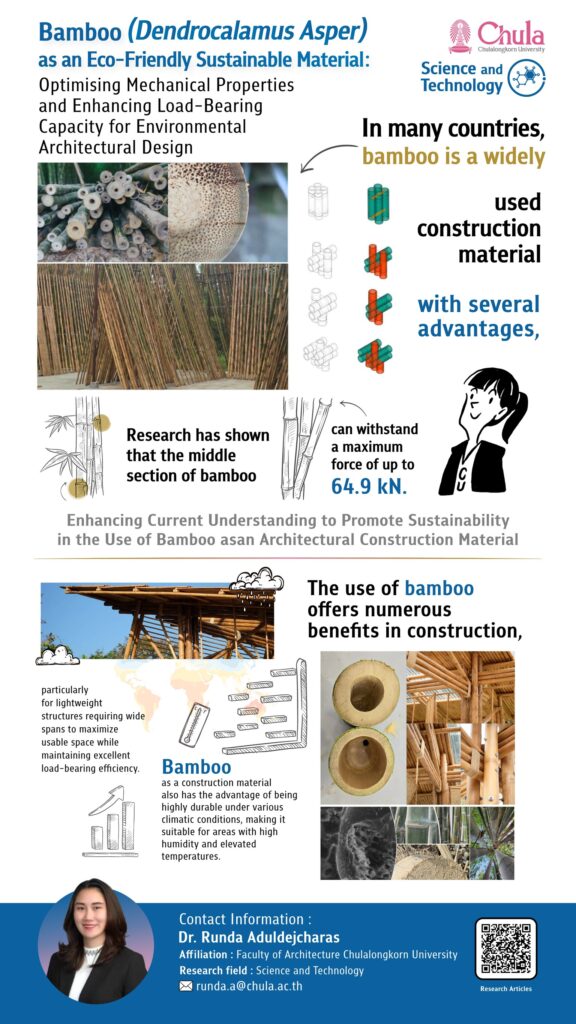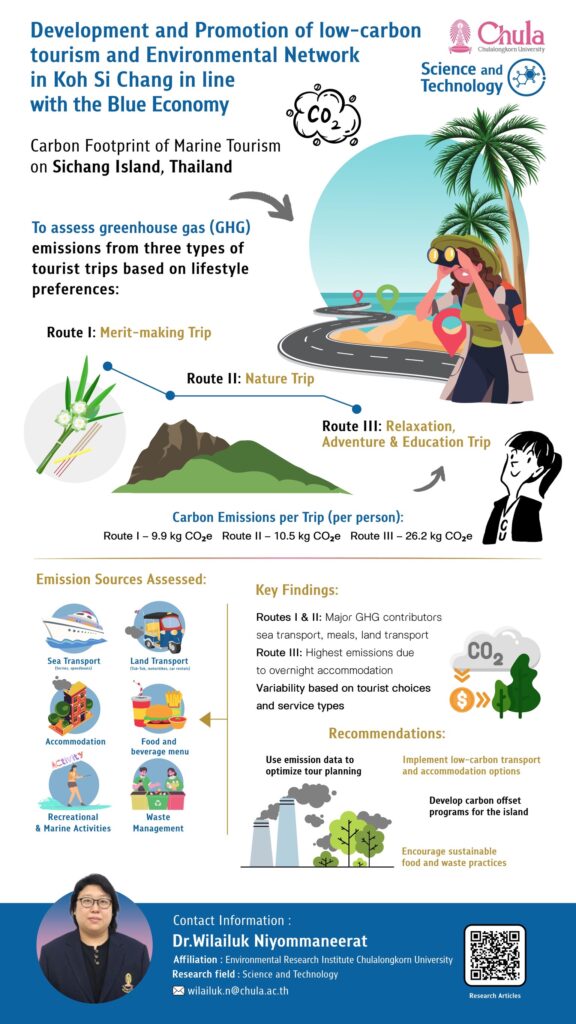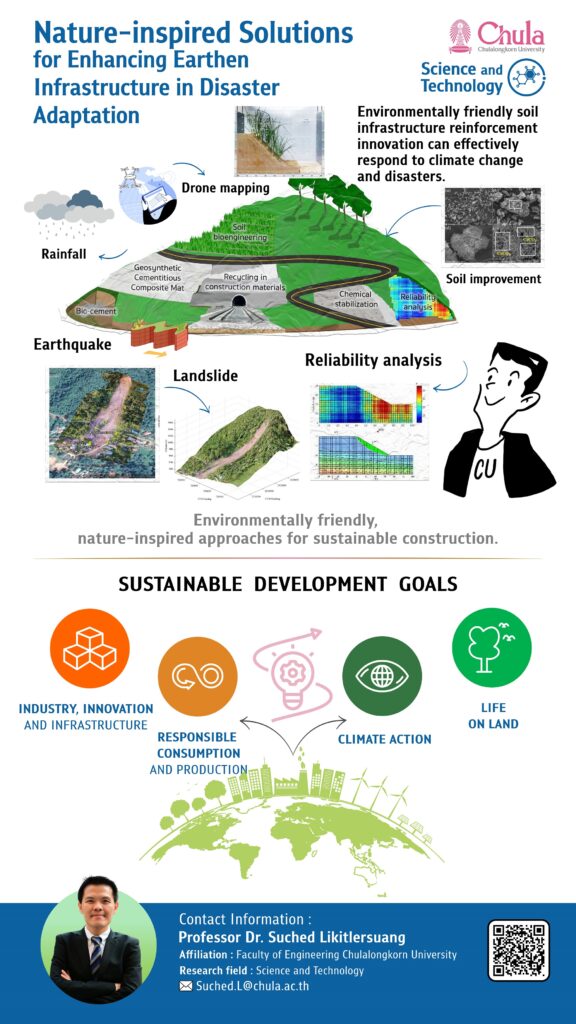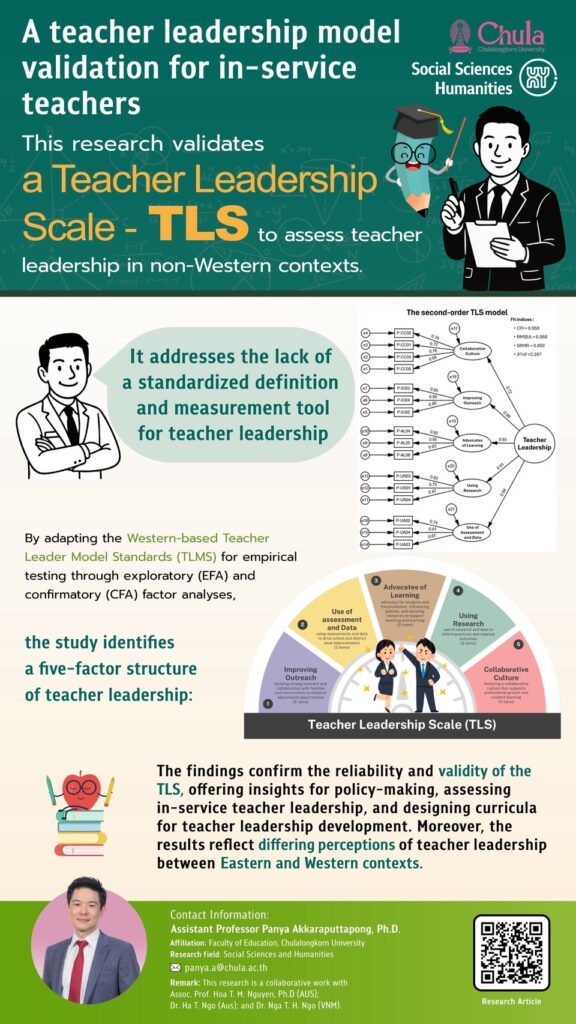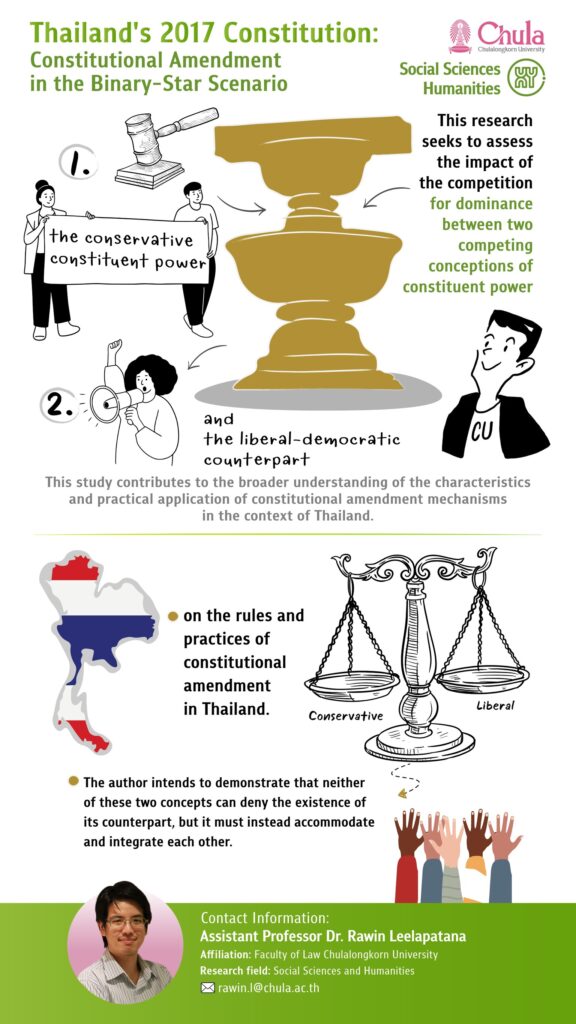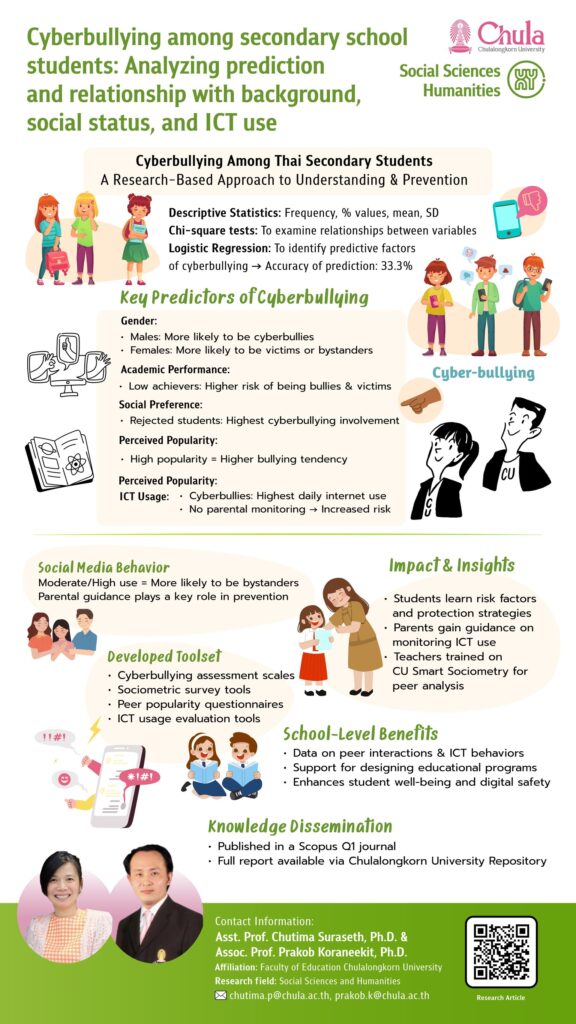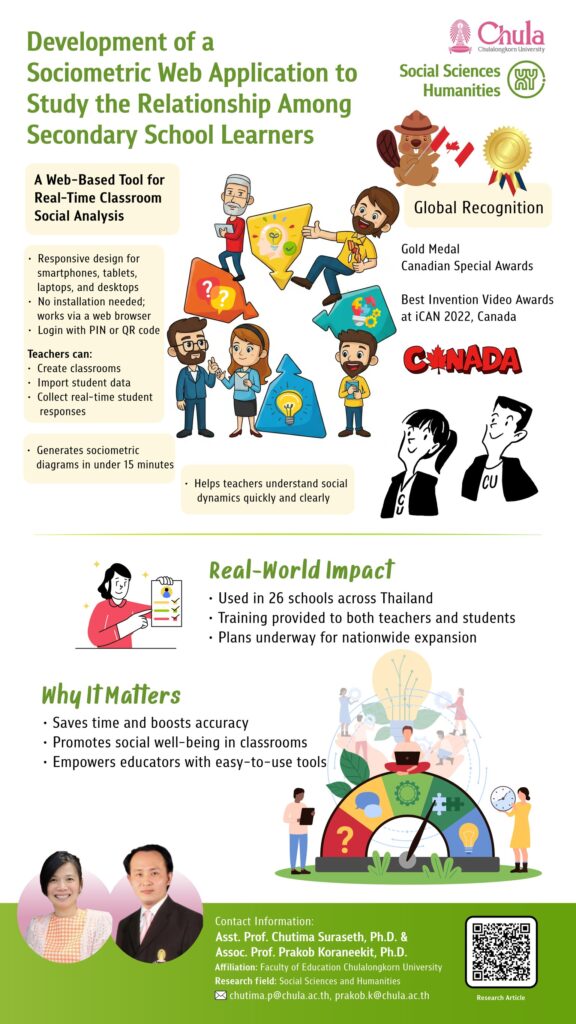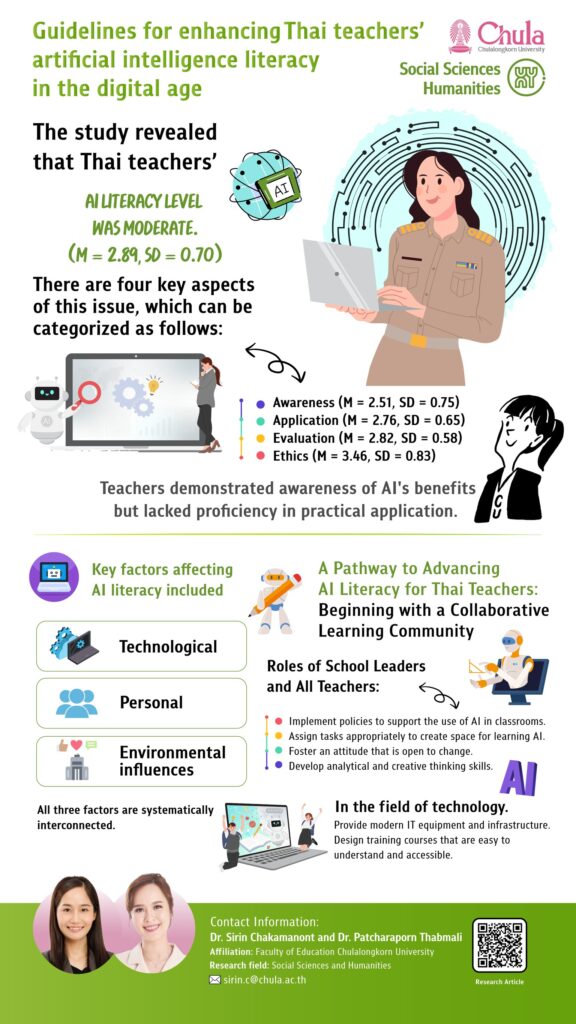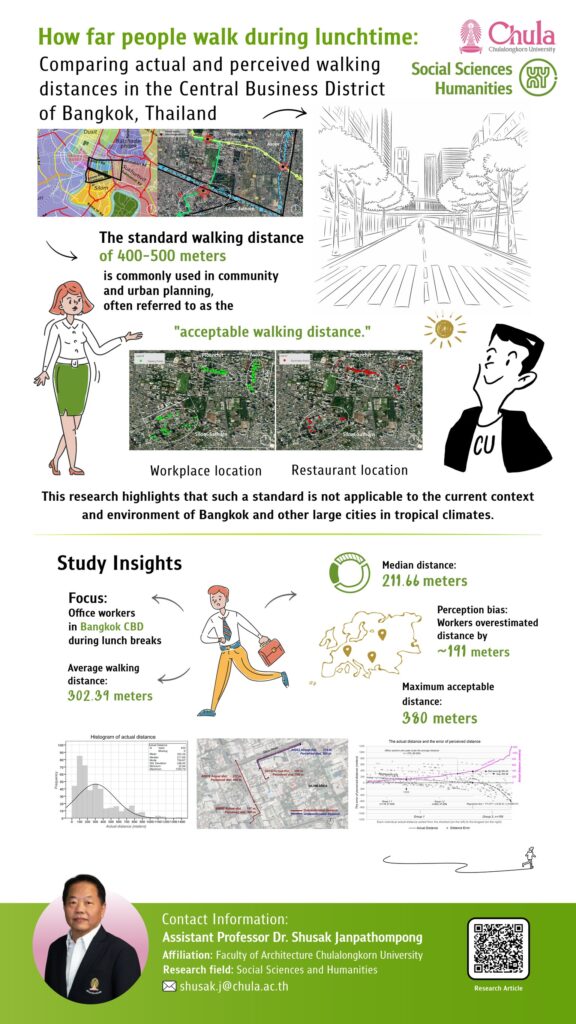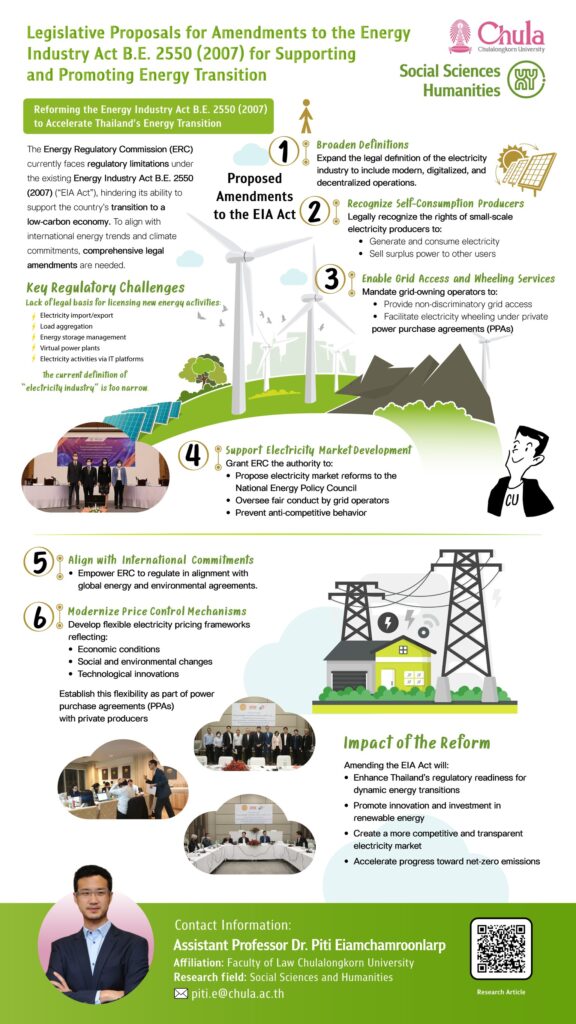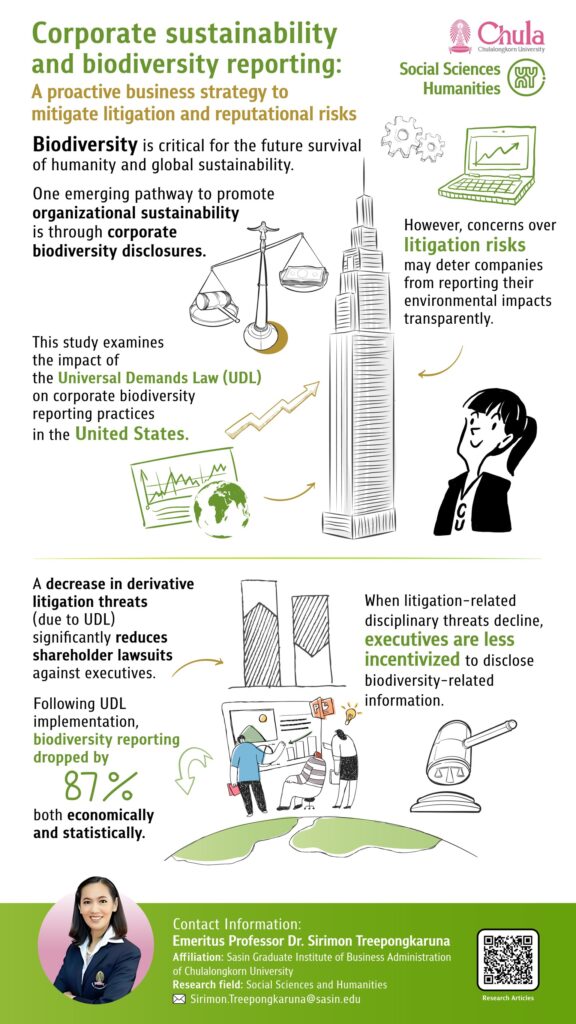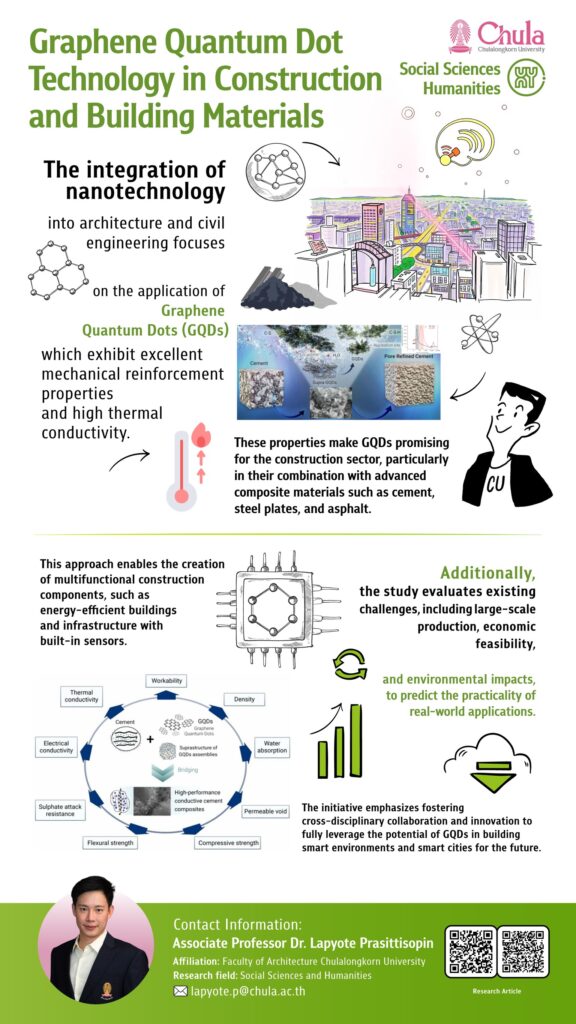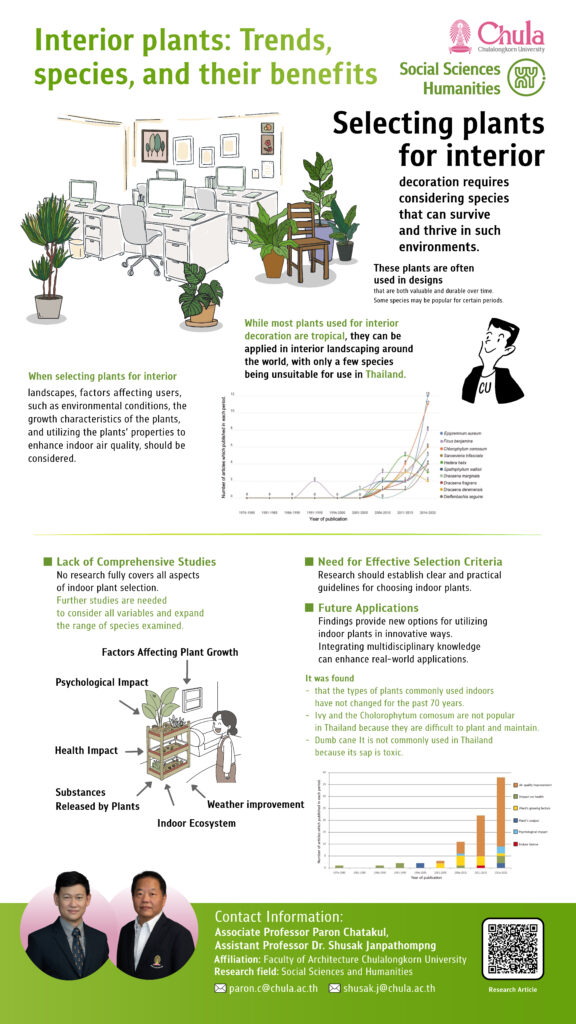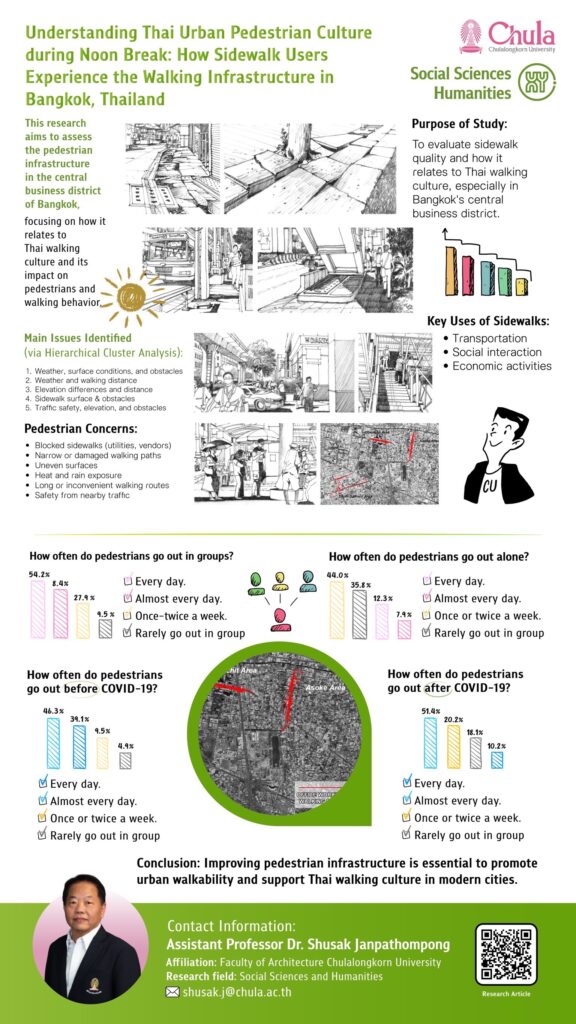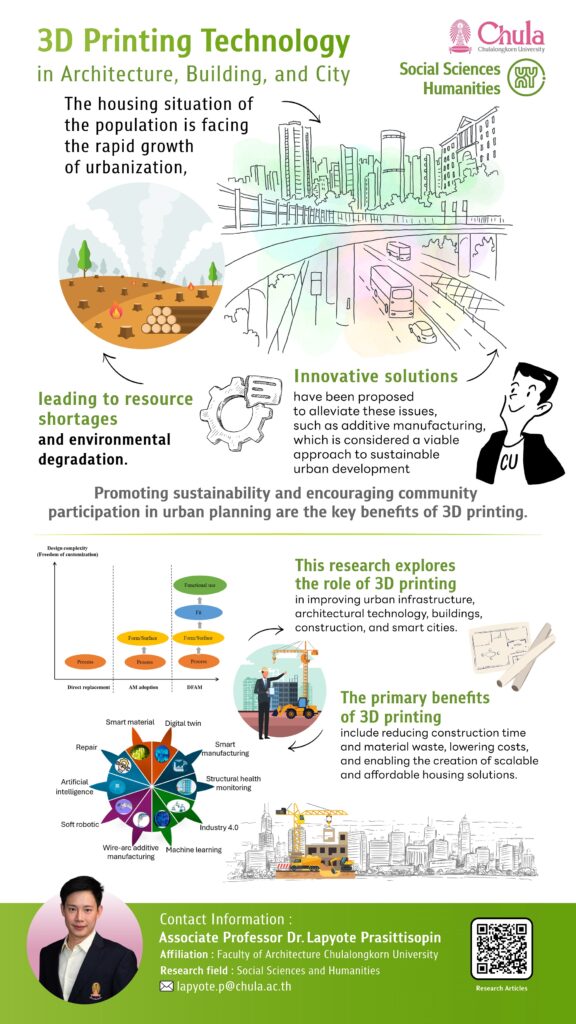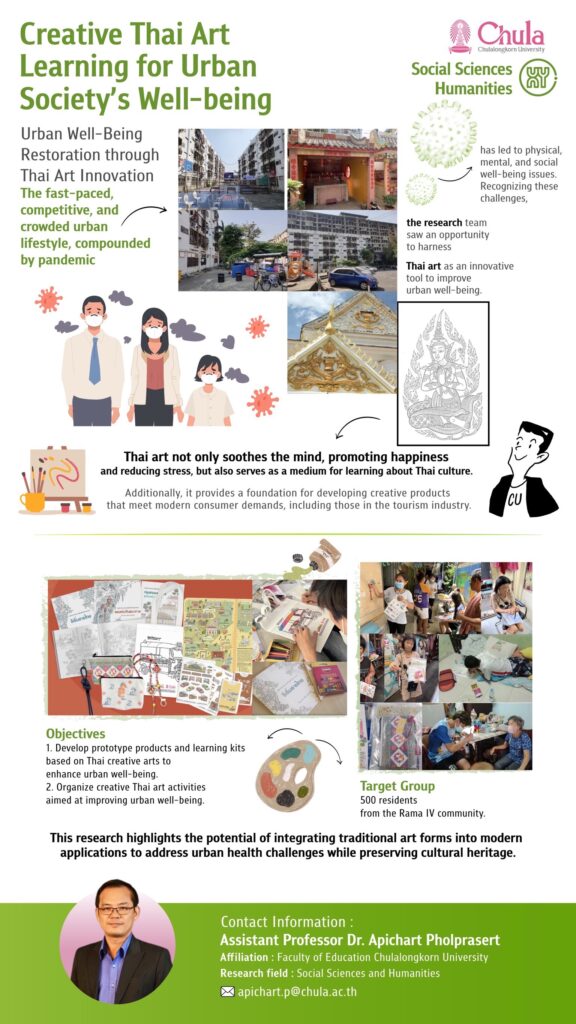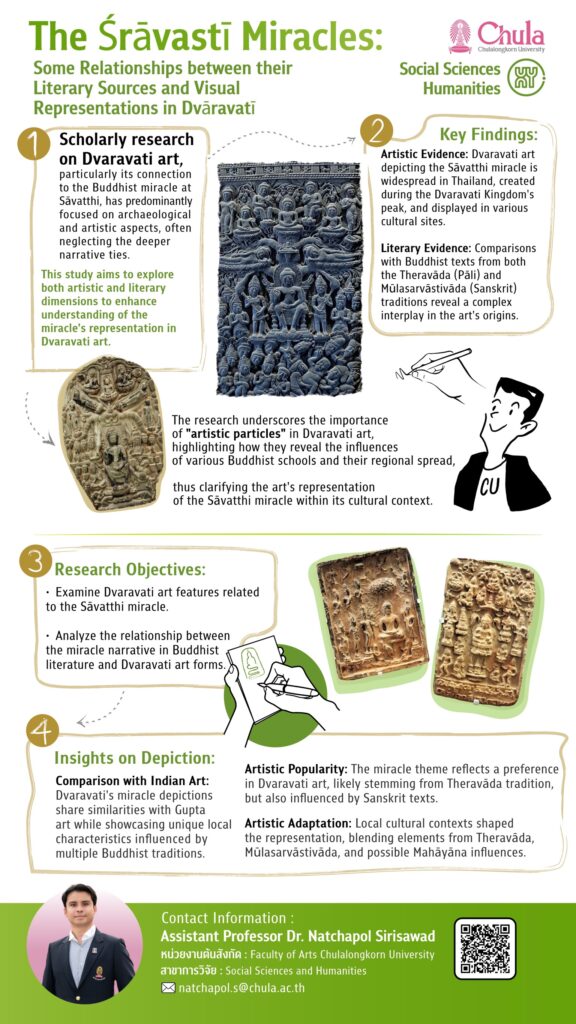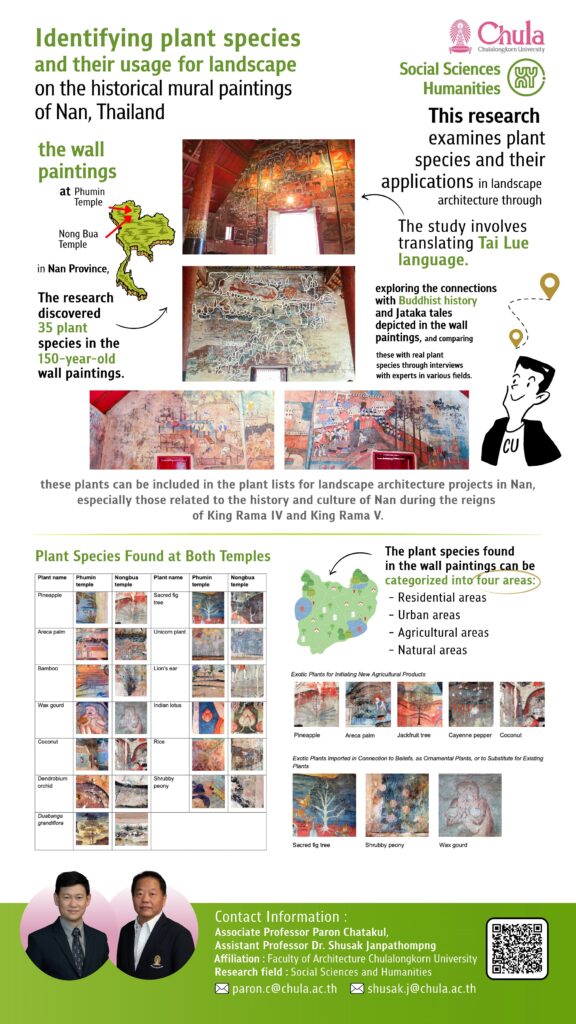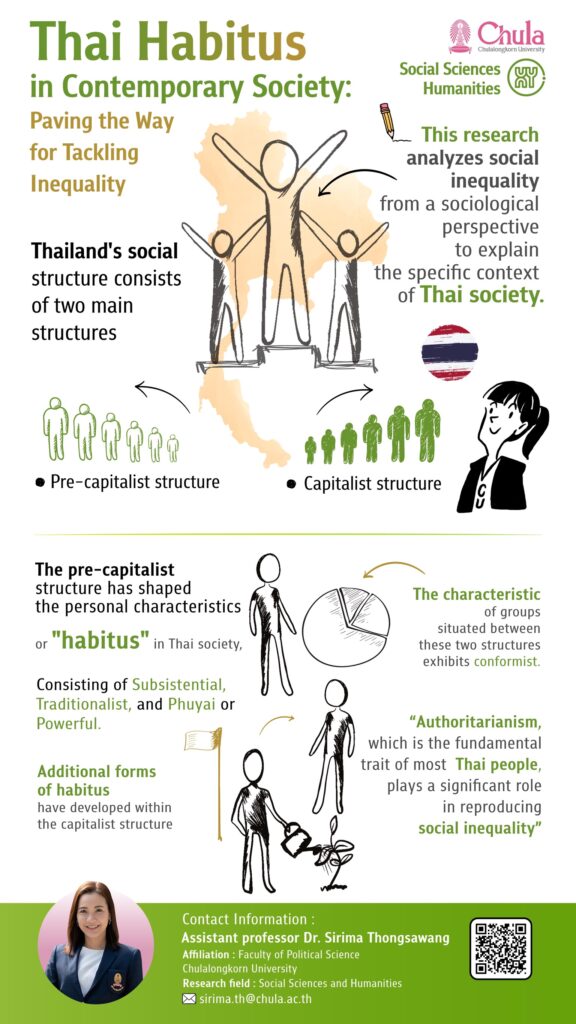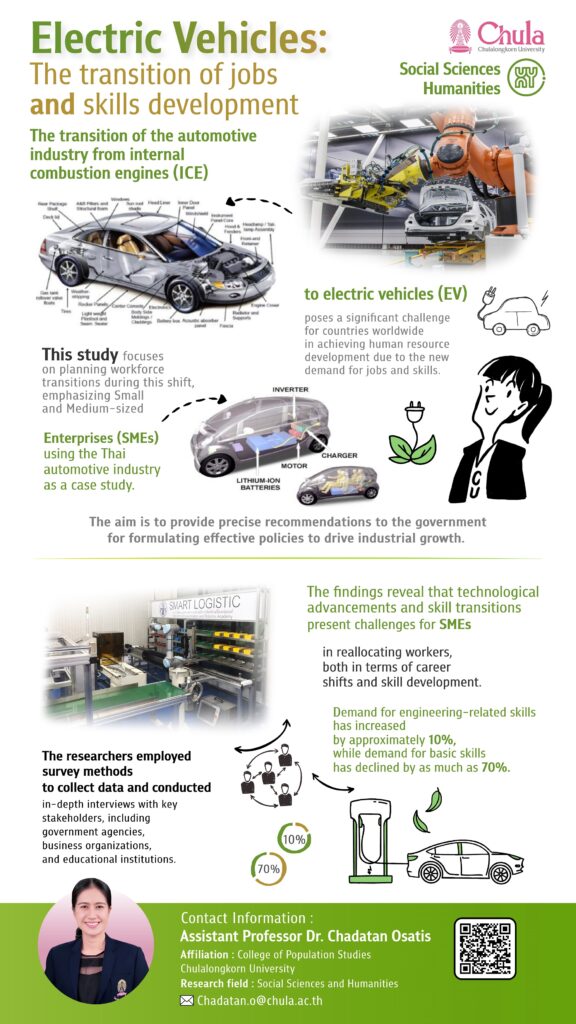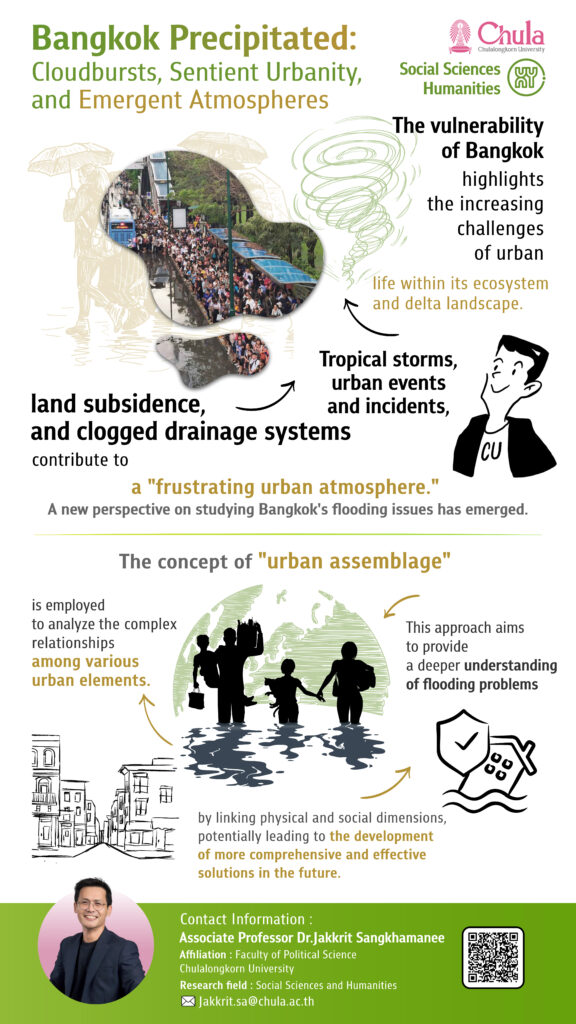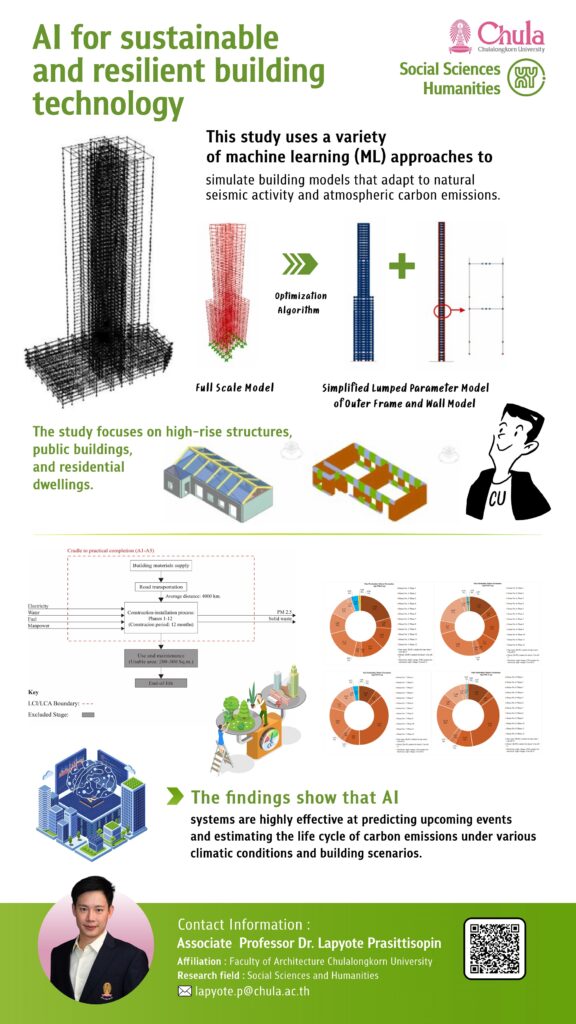CU-Daily Research
April 1, 2025 2025-09-09 22:14CU-Daily Research

The Office of Research Affairs (ORA), Chulalongkorn University is advancing its efforts to enhance the accessibility and usefulness of research communication by transforming faculty and researcher findings into easy-to-understand and engaging infographics.
This approach facilitates the academic community’s ability to build upon knowledge and foster future collaborations. It provides the general public with an accessible and straightforward way to experience Chulalongkorn University’s research and progress innovation.
Find research updates from Chulalongkorn University every day at CU-Daily Research, Starting 1 April 2025.
CU Tomorrow!
#CUDailyResearch #ResearchChula #CUORA
RESEARCH TODAY
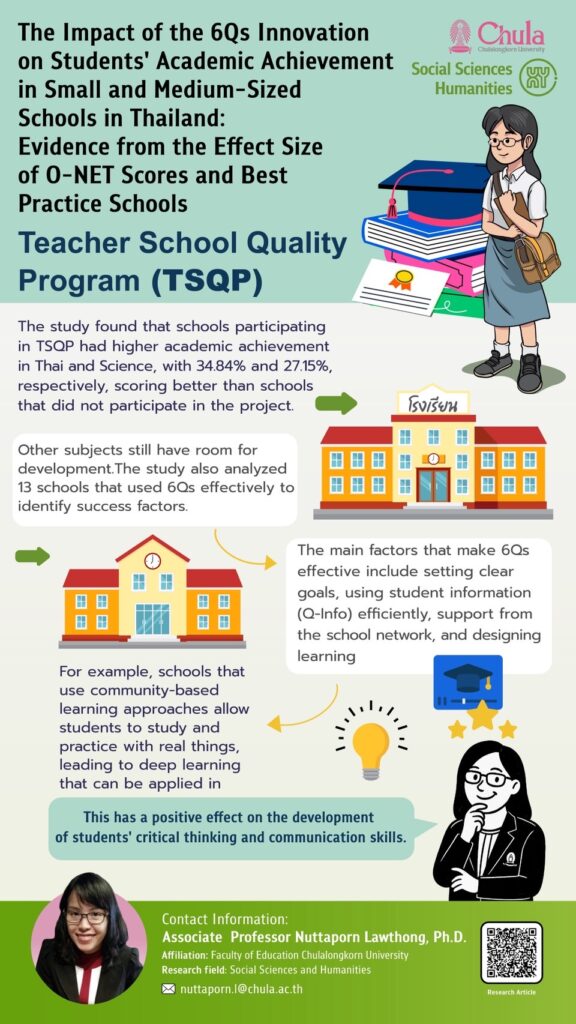
The Impact of the 6Qs Innovation on Students' Academic Achievement in Small and Medium-Sized Schools in Thailand: Evidence from the Effect Size of O-NET Scores and Best Practice Schools
CU-Daily Research Day 100 presents “The Impact of the 6Qs Innovation on Students’ Academic Achievement in Small and Medium-Sized Schools in Thailand: Evidence from the Effect Size of O-NET Scores and Best Practice Schools” by Associate Professor Nuttaporn Lawthong, Ph.D, Faculty of Education
Small and medium-sized schools in Thailand are facing challenges in educational quality. The Equitable Education Fund (EEF) is therefore utilizing the “6Qs” innovation as a guideline to elevate students’ academic achievement.
Chulalongkorn University researchers studied the impact of the Teacher School Quality Program (TSQP) by analyzing O-NET scores. They found that schools participating in the program showed outstanding development. Key factors included clear goal-setting, efficient use of student data, support from school networks, and proactive learning design tailored to local contexts. This leads to reducing educational disparities and creating equal opportunities for all students to sustainably grow into quality members of society.
Keywords
#EducationalEquity #TeacherAndSchoolQualityProgram #WholeSchoolImprovementInnovation #EffectSize
#GoodPracticeSchool #SchoolManagement
SDGs
#SDGs4
Associate Professor Nuttaporn Lawthong, Ph.D
Faculty of Education, Chulalongkorn University
Email: nuttaporn.l@chula.ac.th
Health Sciences

The effect of a self-management programme on blood pressure levels among people with hypertension: a randomised controlled trial
Associate Professor Police Captain Dr. Rapin Polsook
Faculty of Nursing, Chulalongkorn University
Email: rapin.p@chula.ac.th
CU-Daily Research Day 96 presents “The effect of a self-management programme on blood pressure levels among people with hypertension: a randomised controlled trial” by Associate Professor Police Captain Dr. Rapin Polsook, Faculty of Nursing
Hypertension is a significant health problem that can lead to severe complications. Therefore, controlling blood pressure levels is essential for a better quality of life. Researchers at Chulalongkorn University utilized a mobile application to monitor blood pressure, exploring new alternatives for the healthcare of the Thai people.
The experimental results showed that the group using a self-management programme via a mobile application to monitor blood pressure for 4 weeks experienced a reduction in systolic blood pressure. (*but no decrease was found in diastolic blood pressure). This finding highlights the potential of mobile technology as a crucial tool for patients to effectively manage their blood pressure, leading to improved health and a reduced risk of future complications.
#ApplicationBased #BloodPressureLevels #Hypertension #RandomisedControlTrial #SelfManagement #SDGs3 #SDGs9
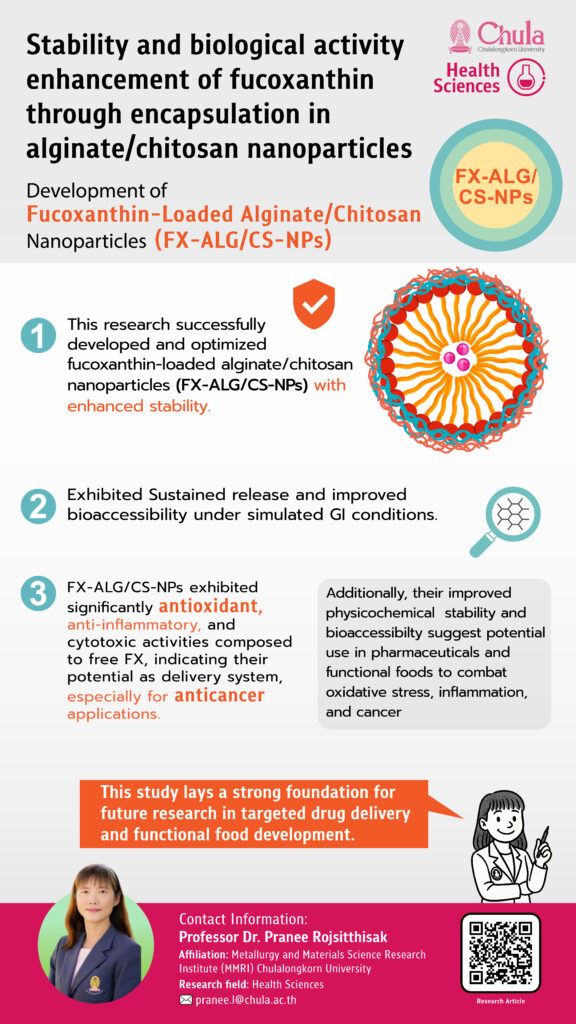
Stability and biological activity enhancement of fucoxanthin through encapsulation in alginate/chitosan nanoparticles
Professor Dr. Pranee Rojsitthisak
Metallurgy and Materials Science Research Institute (MMRI), Chulalongkorn University
Email: pranee.l@chula.ac.th
CU-Daily Research Day 93 presents “Stability and biological activity enhancement of fucoxanthin through encapsulation in alginate/chitosan nanoparticles” by Professor Dr. Pranee Rojsitthisak, Metallurgy and Materials Science Research Institute (MMRI)
Fucoxanthin (FX) is a carotenoid that aids in antioxidation, reduces inflammation, and helps fight cancer, while also supporting weight management. Researchers at Chulalongkorn University have developed nanoparticles to encapsulate this vital compound for the most efficient release in the gastrointestinal system.
This significant research advancement has the potential to lead to the development of more effective medications for patients, particularly those undergoing cancer treatment. Furthermore, it can be developed into dietary supplement products for health-conscious individuals in the future.
#Fucoxanthin #Chitosan #Alginate #Nanoparticles #AntiCancer #SDGs13 #SRL3 #SRL4

Influencing Factors on Death Acceptance Among Thai Older Persons
Associate Professor Dr. Sureeporn Thanasilp
Faculty of Nursing, Chulalongkorn University
Email: Sureeporn.T@chula.ac.th
CU-Daily Research Day 90 presents “Influencing Factors on Death Acceptance Among Thai Older Persons” by Associate Professor Dr. Sureeporn Thanasilp, Faculty of Nursing
‘One day, we all die’ is a common phrase many use to remind themselves to let go and appreciate life. However, for the elderly, who are closest to death, this phrase can profoundly impact the remainder of their lives.
Chulalongkorn University researchers therefore studied the application of Buddhist principles in caring for the elderly. They found that Buddhist beliefs about death, spiritual practices (Dharma practice), and social support significantly reduce anxiety and foster a deeper understanding of death. Nurses and caregivers can apply this information to help Thai elderly individuals experience their final years peacefully and beautifully.
#BuddhistBeliefsAboutDeath #BuddhistPractice #DeathAcceptance #DeathAnxiety #OlderPersons #SDGs3

Innovative Lip Care: Development and Therapeutic Benefits for Dry and Chapped Lips
Dr. Paswach Wiriyakijja, Assistant Professor Pimchanok Sutthiboonyapan, Professor Dr. Pithi Chanvorachote, and Professor Dr. Thantrira Porntaveetus
Faculty of Dentistry, Faculty of Pharmaceutical Sciences, Chulalongkorn University
Email: pimchanok.s@chula.ac.th, paswach.w@gmail.com, pithi.c@chula.ac.th, thantrira.p@chula.ac.th
CU-Daily Research Day 88 presents “Innovative Lip Care: Development and Therapeutic Benefits for Dry and Chapped Lips” by Dr. Paswach Wiriyakijja (Faculty of Dentistry), Assistant Professor Pimchanok Sutthiboonyapan (Faculty of Dentistry), Professor Dr. Pithi Chanvorachote (Faculty of Pharmaceutical Sciences), and Professor Dr. Thantrira Porntaveetus (Faculty of Dentistry)
Do you suffer from dry, chapped lips? Research from Chulalongkorn University presents “Herbal Hydrant Lip Balm,” an innovation that restores softness and moisture to your lips with the power of natural nourishment.
The research found that a suitable blend of extracts from peppermint oil, perilla leaves, and Indian gooseberry synergistically strengthens lip cells. It offers antioxidant properties and stimulates cell regeneration. Clinical tests showed that this lip balm reduces lip roughness within 28 days, especially for those with severely dry and chapped lips.
#Aging #Antioxidant #Cheilitis #HerbalLipHydrant #LipRoughness #Prevention #Stemness #SDGs12
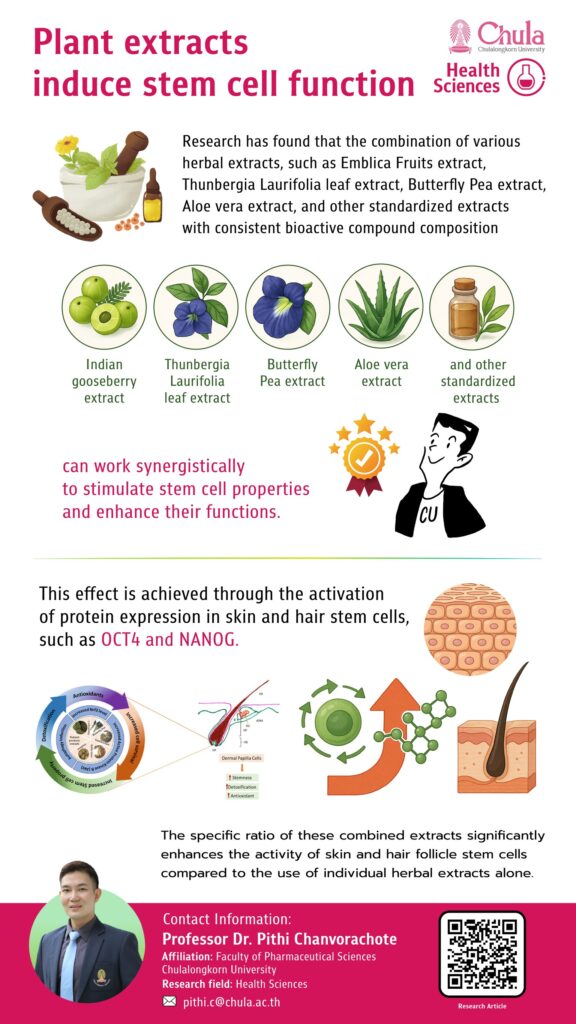
Plant extracts induce stem cell function
Professor Dr. Pithi Chanvorachote
Faculty of Pharmaceutical Sciences, Chulalongkorn University
Email: pithi.c@chula.ac.th
CU-Daily Research Day 87 presents “Plant extracts induce stem cell function” by Professor Dr. Pithi Chanvorachote, Faculty of Pharmaceutical Sciences
Herbs have been used as medicine, skincare products, and hair treatments from ancient times to the present. Some herbs are extracted and incorporated into various products to enhance nourishment and achieve satisfying results for many. But herbs can be developed even further! A discovery by researchers at Chulalongkorn University will make herbal extracts even more potent and distinct.
The research found that combining several herbal extracts—such as Indian gooseberry, Thunbergia Laurifolia, Butterfly Pea, Aloe vera, and other extracts—when subjected to controlled extraction standards and appropriate mixing ratios, will synergistically stimulate and promote the function of skin and hair stem cells. This discovery has the potential to create significant value in the future development of cosmetics, cosmeceuticals, and dietary supplements.
#Herb #StemCell Skin #Hair #Cosmetic #SDGs12

Transforming Nurse Self-Care Through Integration of Spirituality: Lessons From an International Collaboration in Palliative Care
Associate Professor Dr. Sureeporn Thanasilp
Faculty of Nursing, Chulalongkorn University
Email: Sureeporn.T@chula.ac.th
CU-Daily Research Day 86 presents “Transforming Nurse Self-Care Through Integration of Spirituality: Lessons From an International Collaboration in Palliative Care” by Associate Professor Dr. Sureeporn Thanasilp, Faculty of Nursing
Compassion fatigue and burnout among healthcare professionals are frequently observed on social media. Beyond their professional knowledge and abilities, these individuals must also exert immense emotional effort to encourage patients in their fight against illness, often forgetting that they too need emotional support.
Chulalongkorn University researchers therefore invited healthcare professionals to explore their emotional resilience. They found that self-care in the realm of spirituality involves specific and unique expressions, encompassing beliefs, religious practices, community-mindedness, and empowerment. Integrating culturally congruent rituals will help support healthcare professionals in discovering new sources of emotional strength.
#PalliativeCare #TransculturalResearch #HealthCareProviders #CompassionSatisfaction #Spirituality #NursingPractice #ClinicalAreasSelfCare #SDGs3
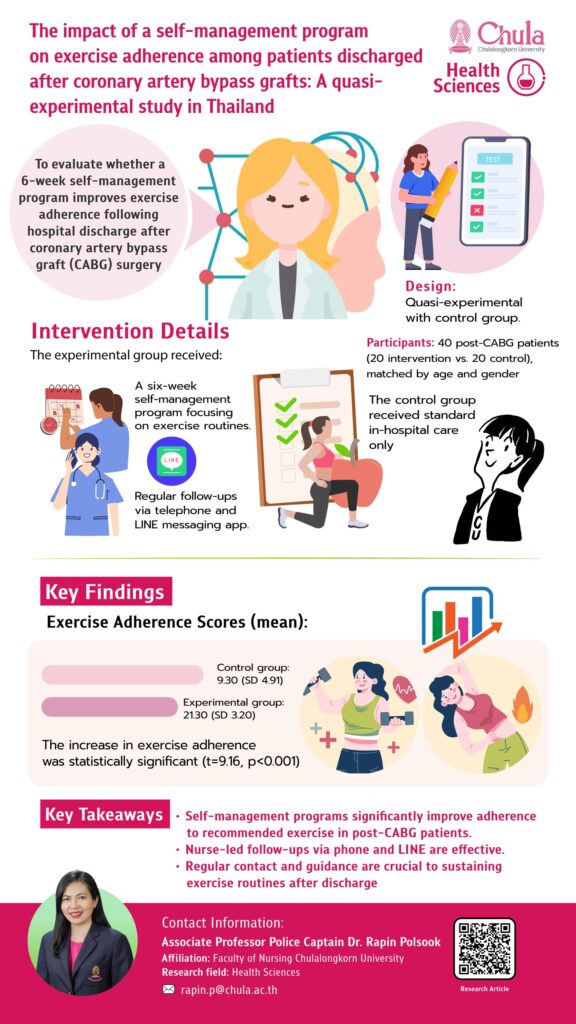
The impact of a self-management program on exercise adherence among patients discharged after coronary artery bypass grafts: A quasi-experimental study in Thailand
Associate Professor Police Captain Dr. Rapin Polsook
Faculty of Nursing, Chulalongkorn University
Email: rapin.p@chula.ac.th
CU-Daily Research Day 84 presents “The impact of a self-management program on exercise adherence among patients discharged after coronary artery bypass grafts: A quasi-experimental study in Thailand” by Associate Professor Police Captain Dr. Rapin Polsook, Faculty of Nursing
Consistent exercise is crucial for patients who have undergone coronary artery bypass graft (CABG) surgery. However, many struggle with adherence, especially in the initial period after hospital discharge, which can negatively impact their health. Chulalongkorn University researchers are therefore focusing on using self-management programs to address this issue.
The research findings indicate that self-management programs are highly effective in helping patients adhere to their exercise plans. This is particularly true when nurses play an active role in providing close encouragement and guidance, both before and after discharge. Additionally, follow-ups via phone or LINE further help patients maintain consistent adherence.
#CoronaryArteryBypassGraft #ExerciseAdherence #SelfManagement #PatientDischarge #Thailand #Nurses #SDGs3

The effect of self-management intervention among type 2 diabetes: A systematic review and meta-analysis
Associate Professor Police Captain Dr. Rapin Polsook
Faculty of Nursing, Chulalongkorn University
Email: rapin.p@chula.ac.th
CU-Daily Research Day 82 presents “The effect of self-management intervention among type 2 diabetes: A systematic review and meta-analysis” by Associate Professor Police Captain Dr. Rapin Polsook, Faculty of Nursing
Diabetes is a common disease among most Thais, especially Type 2 Diabetes, which is often found in middle-aged to elderly individuals. It occurs when the pancreas cannot produce enough insulin, or the body cannot effectively utilize the insulin it produces, leading to high blood sugar levels that the body cannot effectively manage.
To find effective ways to care for diabetic patients, Chulalongkorn University researchers analyzed data from type 2 diabetes patients. They found that patient involvement in self-care can reduce glycated hemoglobin (HbA1c) levels. This involvement will help them achieve better health and adapt more effectively to the disease.
#MetaAnalysis #SelfManagement #Intervention #Type2DiabetesPatients #SDGs3
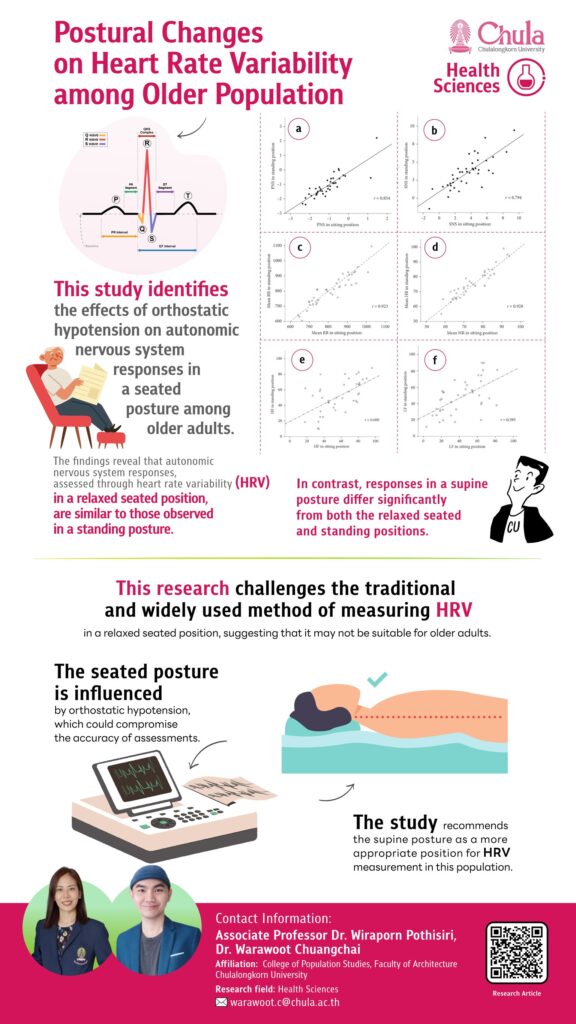
Postural Changes on Heart Rate Variability among Older Population
Associate Professor Dr. Wiraporn Pothisiri and Dr. Warawoot Chuangchai
College of Population Studies, Faculty of Architecture, Chulalongkorn University
Email: wiraporn.p@chula.ac.th, warawoot.c@chula.ac.th
CU-Daily Research Day 76 present “Postural Changes on Heart Rate Variability among Older Population” by Associate Professor Dr. Wiraporn Pothisiri, College of Population Studies and Dr. Warawoot Chuangchai, Faculty of Architecture
Measuring health in the elderly is more delicate than in other age groups because their bodies are constantly changing. For example, they can experience orthostatic hypotension (low blood pressure upon standing), which can easily cause their heart rate measurements to fluctuate.
Researchers at Chulalongkorn University recognized these subtle changes and conducted a study to find the appropriate posture for measuring heart rate in the elderly. They found that simply changing from a ‘sitting position’ to a ‘lying down position’ during heart rate measurement significantly improves the accuracy of the readings. This also helps reduce the risk of the elderly feeling faint during the examination.
#HeartRateVariability #AgingPeople #AutonomicNervousSystem #OrthostaticHypotension #SDGs3
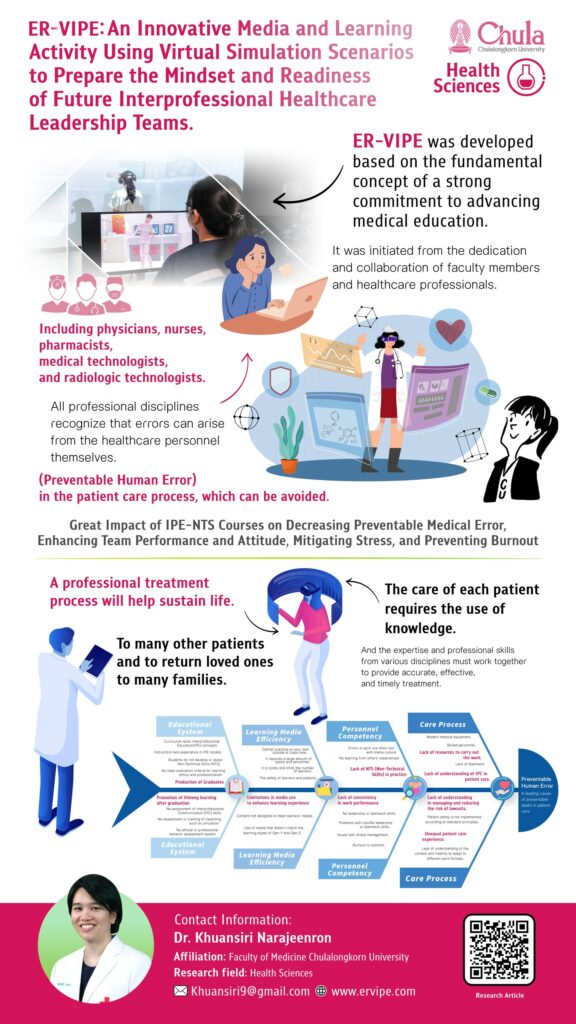
ER-VIPE: An Innovative Media and Learning Activity Using Virtual Simulation Scenarios to Prepare the Mindset and Readiness of Future Interprofessional Healthcare Leadership Teams.
Dr. Khuansiri Narajeenron
Faculty of Medicine, Chulalongkorn University
Email: khuansiri.n@chula.ac.th
CU-Daily Research Day 75 present “ER-VIPE: An Innovative Media and Learning Activity Using Virtual Simulation Scenarios to Prepare the Mindset and Readiness of Future Interprofessional Healthcare Leadership Teams.” by Dr. Khuansiri Narajeenron, Faculty of Medicine
Healthcare professionals belong to a field that demands extensive knowledge, skills, and high precision in treatment. Even a minor treatment error can be a matter of life or death for patients. This not only negatively impacts the physical and mental well-being of patients but also leads to feelings of guilt among healthcare personnel for perceived professional shortcomings. This can result in burnout and, ultimately, a decline in the number of healthcare professionals.
Therefore, Chulalongkorn University research faculty, in collaboration with various multidisciplinary departments, have developed a curriculum to train future healthcare professionals. This training focuses on honing critical thinking, problem-solving, teamwork, and decision-making skills through virtual experiences. The aim is to reduce preventable medical errors, enhance professional efficiency and positive attitudes, and help alleviate stress and prevent burnout. This initiative prepares healthcare professionals to become strong leaders in the future.
#Simulation #InterprofessionalEducation #Movie #MOOC #Teamwork #Communication #CopingWithStress #Burnout #TeamClinicalReasoning #Resillience #SDGs3

Cancer biomarker in white blood cells – A potential technology for cancer screening
Assistant Professor Dr. Charoenchai Puttipanyalears
Faculty of Medicine, Chulalongkorn University
Email: charoenchai.p@chula.ac.th
CU-Daily Research Day 74 present “Cancer biomarker in white blood cells – A potential technology for cancer screening” by Assistant Professor Dr. Charoenchai Puttipanyalears, Faculty of Medicine
Cancer remains a severe global threat. Early detection of cancer is crucial for increasing treatment opportunities and reducing mortality rates. However, current diagnostic methods are complex, painful, and expensive, making essential screenings inaccessible to many patients.
Researchers at Chulalongkorn University are investigating methods to identify simple and effective approaches by examining molecular changes in the white blood cells of cancer patients. These changes result from direct signaling by cancer cells. This discovery will lead to the development of ‘biomarkers,’ which will enable rapid, accurate, and straightforward cancer screening.
#Biomarker #WhiteBloodCell #Cancer #SDGs3

F8 variants and their genotype-phenotype correlations in Thai patients with haemophilia A: a nationwide multicentre study
Professor Darintr Sosothikul
Faculty of Medicine, Chulalongkorn University
Email: Darintr.S@chula.ac.th
CU-Daily Research Day 73 present “F8 variants and their genotype-phenotype correlations in Thai patients with haemophilia A: a nationwide multicentre study” by Professor Darintr Sosothikul, Faculty of Medicine
‘Haemophilia’ is a disease where patients can bleed easily into their joints or muscles, and the bleeding is difficult to stop because the body lacks proteins responsible for clotting, known as ‘factors.’ There are two types: Factor VIII (F8) and Factor IX (F9), and it primarily affects males. Females usually do not show symptoms but are carriers who can pass on the abnormal gene to their children.
A doctor-researcher from Chulalongkorn University found that the severity of haemophilia A in Thailand is mostly due to abnormal gene bases and mild mutations. This enables a more accurate prediction of the risk of complications and facilitates more effective individual patient care planning.
#GeneticDiseases #Inborn #HemophiliaA #Hemostasis #SDGs3
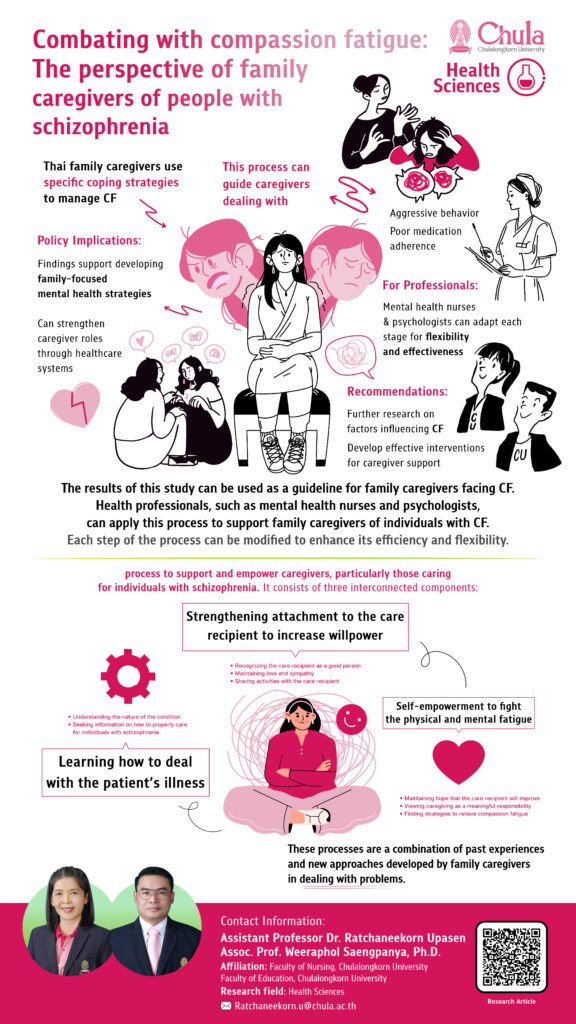
Combating with Compassion Fatigue: The Perspective of Family Caregivers of People with Schizophrenia
Assistant Professor Dr. Ratchaneekorn Upasen and Associate Professor Dr. Weeraphol Saengpanya
Faculty of Nursing, Faculty of Education, Chulalongkorn University
Email: Ratchaneekorn.u@chula.ac.th, weeraphol.s@chula.ac.th
CU-Daily Research Day 70 presents “Combating with Compassion Fatigue: The Perspective of Family Caregivers of People with Schizophrenia” by Assistant Professor Dr. Ratchaneekorn Upasen, Faculty of Nursing and Associate Professor Dr. Weeraphol Saengpanya, Faculty of Education
Families caring for patients with schizophrenia represent another group whose mental well-being should not be overlooked. Their close caregiving role often leads to ‘Compassion Fatigue (CF),’ which, beyond physical exhaustion, impacts their mental state, causing disappointment, stress, guilt, social isolation, and a reduction in various life capacities.
Researchers at Chulalongkorn University are therefore seeking strategies and coping mechanisms for the mental vulnerabilities faced by family caregivers of schizophrenia patients, as well as healthcare professionals. The aim is to develop effective support guidelines, help caregivers overcome the challenges of caring for schizophrenia patients, promote caregiver well-being, and simultaneously enhance mental health services in Thailand.
#CompassionFatigue #Schizophrenia #Caregivers #GroundedTheory #SDGs3

RFA for reducing the risk of gastric cancer
Associate Professor Rapat Pittayanon, M.D.
Faculty of Medicine, Chulalongkorn University
Email: rapat.p@chula.ac.th
CU-Daily Research Day 65 presents “RFA for reducing the risk of gastric cancer” by Associate Professor Rapat Pittayanon, M.D., Faculty of Medicine
Radiofrequency ablation, or ‘RFA,’ is a treatment method using radiofrequency waves to destroy abnormal tissues and cancer cells and also to treat arrhythmias. It is a straightforward, precise, and effective treatment.
A doctor from Chulalongkorn University’s Faculty of Medicine has studied this process to treat a condition of the gastric lining that could potentially develop into stomach cancer in the future. They found that the RFA method can inhibit or reduce the risk of stomach cancer, leading to less frequent follow-ups for patients and an improved quality of life.
#RFA #GastricCancer #SDGs3

Nanodrug delivery system: Kaempferia parviflora extracellular vesicles
Associate Professor Dr. Nuntaree Chaichanawongsaroj
Faculty of Allied Health Sciences, Chulalongkorn University
Email: nuntaree@gmail.com
CU-Daily Research Day 62 presents “Nanodrug delivery system: Kaempferia parviflora extracellular vesicles” by Associate Professor Dr. Nuntaree Chaichanawongsaroj, Faculty of Allied Health Sciences
Black galingale is a Thai herb with medicinal properties that has been used since ancient times. Researchers at Chulalongkorn University have developed this Thai herb into a nano-delivery drug innovation, reducing stomach irritation.
This nano-delivery system can withstand stomach acid, allowing the drug to be released precisely at its target. It helps the medication reach stomach cells more effectively than conventional drugs and significantly reduces inflammation. This format can also be adapted for other types of medication in the future.
#ExtracellularVesicle #Clarithromycin #KaempferiaParviflora #HelicobacterPylori #Inflammation #SDGs3
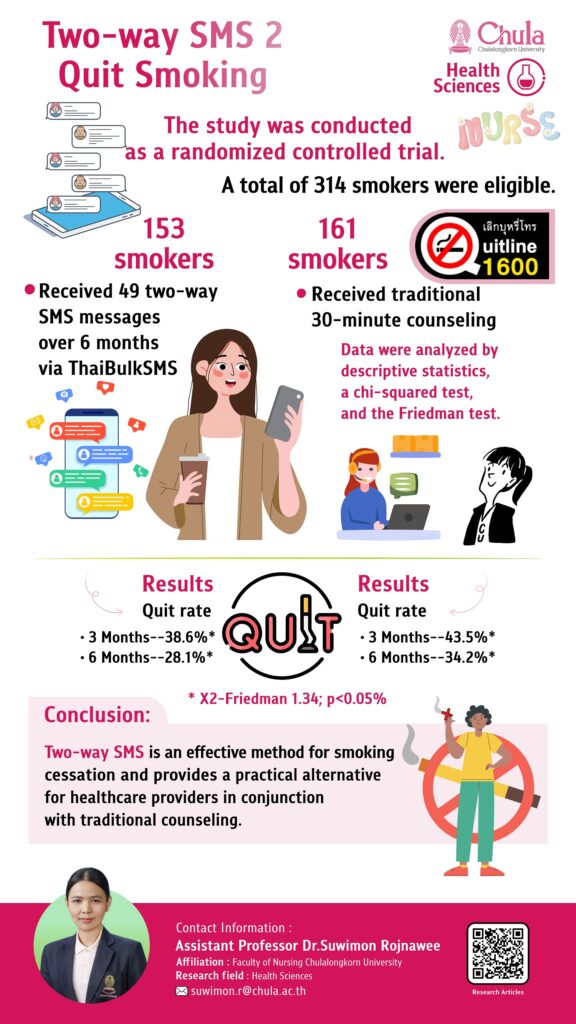
Two-way SMS 2 Quit Smoking
Assistant Professor Dr. Suwimon Rojnawee
Faculty of Nursing, Chulalongkorn University
Email: suwimon.r@chula.ac.th
CU-Daily Research Day 61 presents “Two-way SMS 2 Quit Smoking” by Assistant Professor Dr. Suwimon Rojnawee, Faculty of Nursing
One interesting way to quit smoking is to communicate with others who also want to quit by exchanging short text messages via ThaiBulk SMS for six months. The study found that sending short text messages can actually help people quit smoking. This is a new option that plays a role in healthcare and can be further developed for healthcare in other areas.
Because messages that aim to promote or support quitting smoking are important for the morale of those who want to quit. It’s an affordable option and can be implemented immediately.
#TextMessage #QuitSmoking #SDGs3

Quantification of domestic cat hepadnavirus (DCHBV) DNA in various body fluid specimens of cats: the potential viral shedding routes
Professor Dr. Somporn Techangamsuwan
Faculty of Veterinary Science, Chulalongkorn University
Email: somporn.t@chula.ac.th
CU-Daily Research Day 59 presents “Quantification of domestic cat hepadnavirus (DCHBV) DNA in various body fluid specimens of cats: the potential viral shedding routes” by Professor Dr. Somporn Techangamsuwan, Faculty of Veterinary Science
Did you know? Cats can get hepatitis too! Veterinarians at Chulalongkorn University are investigating the possibility of transmission and studying the genetic diversity of the virus to improve treatment efficacy for our feline friends.
Researchers found that the Feline Hepatitis B virus (DCHBV) can be detected in bodily fluids from cats, especially in blood and ear canal samples. In some cases, persistent and prolonged infections were observed. Detecting the virus in these samples is beneficial for studying its spread and developing preventive measures in the future.
#DCH #BodyFluidSpecimens #Detection #HorizontalTransmission #SheddingRoutes #Cat #SDGs3

“Wearing-off” efficacy of CGRP monoclonal antibodies for migraine prevention: A meta-analysis of randomized controlled trials
Associate Professor Dr. Thanin Asawavichienjinda, MD
Faculty of Medicine, Chulalongkorn University
Email: thanin.a@chula.ac.th
CU-Daily Research Day 58 presents “Wearing-off” efficacy of CGRP monoclonal antibodies for migraine prevention: A meta-analysis of randomized controlled trials” by Associate Professor Dr. Thanin Asawavichienjinda, MD, Faculty of Medicine
Migraine is a disease that significantly diminishes quality of life, with both episodic and chronic forms. To reduce the frequency of pain, doctors use CGRP monoclonal antibodies administered via subcutaneous injection or intravenous drip every 1-3 months.
A doctor from Chulalongkorn University’s Faculty of Medicine found that the diminished efficacy of the medication causes migraine patients to experience symptoms again before their next scheduled injection. Therefore, this research investigates the correlation with medication use and aims to plan treatment to improve the quality of life for migraine patients.
#WearingOffEfficacy #Effect #CGRP #MonoclonalAntibodies #MigrainePrevention #Prophylaxis #SDGs3

Etiologies of non-surgical root canal treatment in the Thai population
Associate Professor Piyanee Panitvisai, M.D., Professor Dr. Thantrira Porntaveetus, Sirimas Lerdchakorn, D.D.S., and Assistant Professor Sirinya Kulvitit
Faculty of Dentistry, Chulalongkorn University
Email: sirinya.ku@chula.ac.th, thantrira.p@chula.ac.th
CU-Daily Research Day 56 presents “Etiologies of non-surgical root canal treatment in the Thai population” by Associate Professor Piyanee Panitvisai, M.D., Professor Dr. Thantrira Porntaveetus, Sirimas Lerdchakorn, D.D.S., and Assistant Professor Sirinya Kulvitit, Faculty of Dentistry
Good dental care isn’t just about brushing your teeth cleanly. The dentists from Chulalongkorn University’s Faculty of Dentistry are here to explain the importance of essential oral health care that should be done annually!
The dentist states that the most commonly treated permanent teeth are the molars. Brushing your teeth with fluoride toothpaste, reaching your back teeth, and using dental floss are simple ways to maintain good basic dental health. Additionally, annual dental check-ups to screen for cavities and other oral diseases help in planning treatment before problems escalate.
#RootCanalTreatment #Etiologies #PreventiveMeasures #SDGs3

Anti-acne film forming solution from Hom Thong Pathum banana peel extracts
Dr. Kasinee Katelekha, Baddariyah Sohsansa, Nareeya Waloh, and Sunainee Mahama
The Halal Science Center, Chulalongkorn University
Email: Baddariyah.hsc@gmail.com, info.hsc.cu@gmail.com
CU-Daily Research Day 50 presents “Anti-acne film forming solution from Hom Thong Pathum banana peel extracts” by Dr. Kasinee Katelekha, Baddariyah Sohsansa, Nareeya Waloh, and Sunainee Mahama, The Halal Science Center
For any ladies struggling with uneven makeup due to breakouts and finding acne patches ineffective,researchers at Chulalongkorn University offer a beauty solution: a transparent skin-coating film that provides light coverage, helps treat acne, and allows makeup application without clogging pores.
This transparent acne-reducing film, derived from ‘Pathum Thong’ banana peel extract, reduces the need for antibiotics. It comes in a lightweight, easily absorbed, non-sticky, and skin-safe coating film. Importantly, it also meets halal cosmetic standards.
#HomThongPathumBananaPeel #AntiAcneFilm #HalalProduct #SDGs12
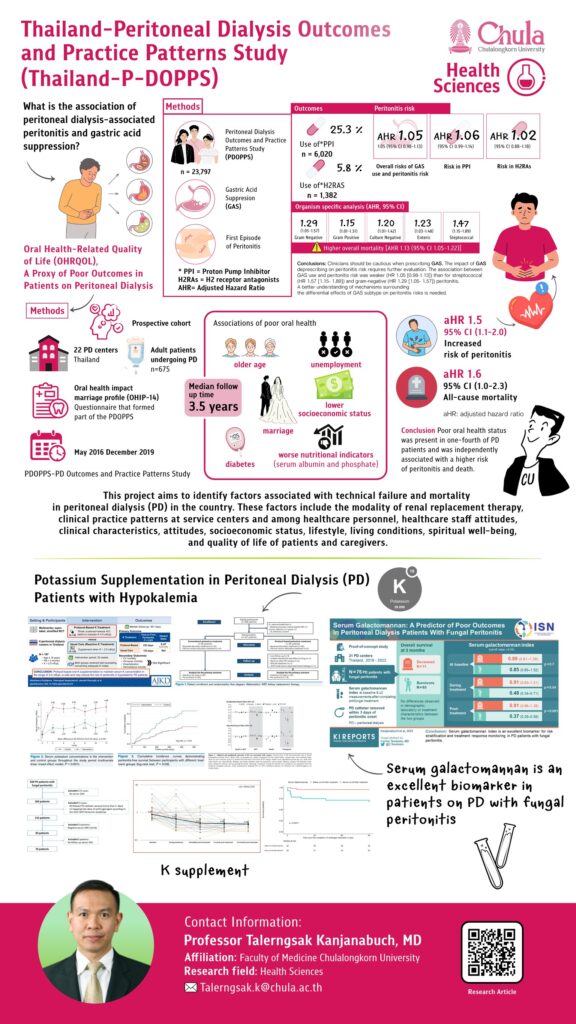
Thailand-Peritoneal Dialysis Outcomes and Practice Patterns Study (Thailand-P-DOPPS)
Professor Talerngsak Kanjanabuch, MD
Faculty of Medicine, Chulalongkorn University
Email: Talerngsak.k@chula.ac.th
CU-Daily Research Day 49 presents “Thailand-Peritoneal Dialysis Outcomes and Practice Patterns Study (Thailand-P-DOPPS)” by Professor Talerngsak Kanjanabuch, MD, Faculty of Medicine
Patients in Thailand who require treatment with Peritoneal Dialysis (PD) face a significant risk of mortality. It is anticipated that other factors may contribute to technical failures that could lead to patient death.
This research found that the majority of deaths often occur within the first year, resulting from several factors, including the patient’s physical condition and inadequate care, insufficient related hospital personnel, unfavorable health insurance coverage, and also a higher incidence of infection.
#PDFirstPolicy #PeritonealDialysis #TechniqueFailure #CultureNegativePeritonitis #PatientSurvival #Hypokalemia #FungalPeritonitis #SDGs3 #SDGs10
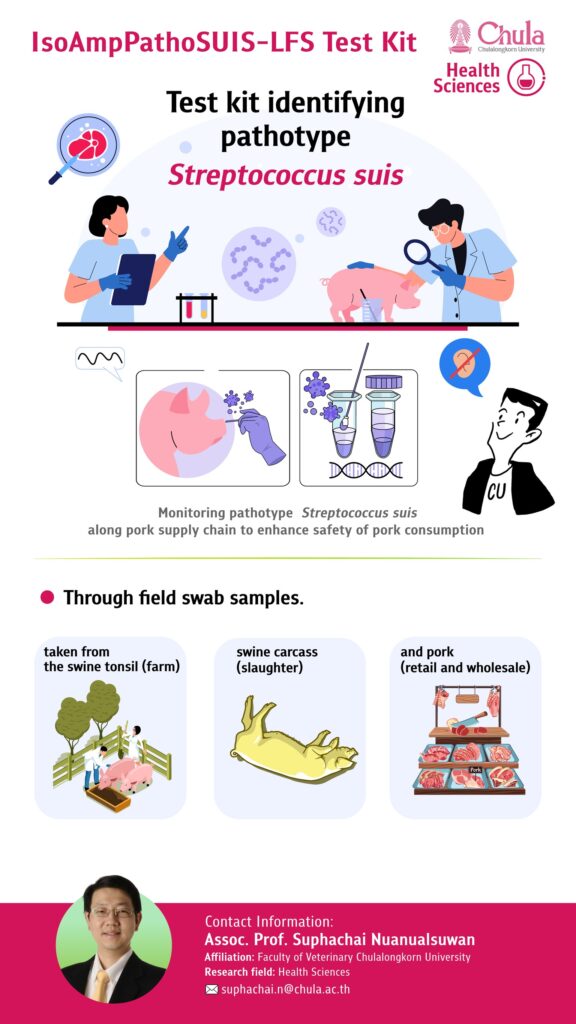
IsoAmpPathoSUIS-LFS Test Kit
Associate Professor Suphachai Nuanualsuwan
Faculty of Veterinary Science, Chulalongkorn University
Email: suphachai.n@chula.ac.th
CU-Daily Research Day 46 presents “IsoAmpPathoSUIS-LFS Test Kit” by Associate Professor Suphachai Nuanualsuwan, Faculty of Veterinary Science
As we all know, to avoid Streptococcus suis infection (swine streptococcosis), one should consume thoroughly cooked pork. For grilling or shabu-shabu, separate chopsticks should be used for raw and cooked pork. Even if we are well aware and take great precautions, if the source doesn’t consistently monitor safety and prevent infection from the farm raising process, slaughtering, and market stall display, consumers still risk contracting the bacteria.
Veterinarians at Chulalongkorn University have invented a user-friendly method for detecting Streptococcus suis, with results available within 40 minutes. This enables rapid disease surveillance and control, enhancing the safety of the pork production process at every stage, from farm to consumer.
#StreptococcusSuis #PCR #Serotype #Pathotype #SDGs3 #SDGs12

Case Cerebral Artery Vasoconstriction After Galcanezumab Loading Dose for Migraine Prevention
Associate Professor Dr. Thanin Asawavichienjinda, MD
Faculty of Medicine, Chulalongkorn University
Email: thanin.a@chula.ac.th
CU-Daily Research Day 45 presents “Case Cerebral Artery Vasoconstriction After Galcanezumab Loading Dose for Migraine Prevention” by Associate Professor Dr. Thanin Asawavichienjinda, MD, Faculty of Medicine
Those familiar with ‘migraines’ know all too well that once they start, they’re hard to shake, requiring ongoing symptomatic treatment. However, for chronic sufferers who experience frequent episodes, it’s truly disheartening as it disrupts their ability to live a normal, happy life. This places a significant burden on physicians to find effective treatments with minimal side effects.
In this research, doctors took on the role of researchers, carefully observing migraine patients receiving their first dose of galcanezumab for migraine prevention. They found that patients treated with CGRP (Calcitonin Gene-Related Peptide) antagonists require special attention, as they may experience prolonged migraine aura or symptoms resembling transient reversible cerebral vasoconstriction syndrome (RCVS), as well as other side effects that impact their daily lives.
#CaseReport #CerebralArteryVasoconstriction #CGRP #Galcanezumab #Migraine #MigraineWithAura #SDGs3

Lipid-ฺBased Nanoparticles for Biomedical and Cosmeceutical Applications
Professor Dr. Voravee Hoven
Faculty of Science, Chulalongkorn University
Email: vipavee.p@chula.ac.th
CU-Daily Research Day 43 presents “Lipid-ฺBased Nanoparticles for Biomedical and Cosmeceutical Applications” by Professor Dr. Voravee Hoven, Faculty of Science
Nowadays, we consume or receive a large number of substances into our bodies. This may partly be because essential substances cannot reach their target cells. These substances might degrade along the way, similar to an injection missing its mark or cream not being absorbed by the skin.
Therefore, researchers at Chulalongkorn University have invented a new type of lipid molecule with medical benefits. It can form stable, non-toxic, and non-inflammatory lipid nanoparticles for delivering mRNA. In the beauty industry, it can encapsulate Growth Factors that stimulate collagen production in the skin. These nanoparticles are small and can retain 70-80% of the active substances.
#LipidNanoparticles #LNPs #mRNAVaccine #Polymer #SDGs3

Revolutionizing Biological Preservation: The Zero-Formalin Solution
Associate Professor Kongkiat Srisuwatanasagul
Faculty of Veterinary Science, Chulalongkorn University
Email: Kongkiat.S@chula.ac.th
CU-Daily Research Day 41 presents “Revolutionizing Biological Preservation: The Zero-Formalin Solution” by Associate Professor Kongkiat Srisuwatanasagul, Faculty of Veterinary Science
Formalin is a commonly used chemical for preserving cadavers, but it is also a carcinogen and can irritate the mucous membranes of those exposed. Furthermore, it causes the tissues and muscles of the body to stiffen and lose color, potentially leading to misunderstandings in the anatomical studies of veterinary students.
The Zero-Formalin Solution (ZF), developed through experiments by Chulalongkorn University researchers, has been found to preserve cadavers as effectively as formalin while maintaining the integrity and freshness of organs. Additionally, it is safer to use than traditional chemicals. The conclusion is that ZF can be used as a substitute for formalin in preserving animal cadavers for study.
#EmbalmingSolution #Preservation #Cat #GrossAnatomy #SDGs3 #SDGs4 #SDGs12

Comparative Analysis of Salmonella Contamination in Pork Slaughtering Facilities: Implications for Food Safety
Associate Professor Dr. Nuvee Prapasarakul and Imporn Saenkankam
Faculty of Veterinary Science, Chulalongkorn University
Email: nuvee.p@chula.ac.th, imporn.tfg@gmail.com
CU-Daily Research Day 39 presents “Comparative Analysis of Salmonella Contamination in Pork Slaughtering Facilities: Implications for Food Safety” by Associate Professor Dr. Nuvee Prapasarakul and Imporn Saenkankam, Faculty of Veterinary Science
Salmonella is a major cause of gastroenteritis worldwide, largely associated with pork products. Therefore, to ensure consumer safety and enable timely management of outbreaks, it is crucial to find ways to reduce Salmonella contamination in pork to prevent harm to consumers from the outset.
This study was conducted in Thailand and aimed to investigate Salmonella contamination to control quality according to the Hazard Analysis Critical Control Points (HACCP) system. It focused on measuring the prevalence of Salmonella contamination, identifying common serotypes, and analyzing the overall pattern of antimicrobial resistance.
#DrugResistance #HACCP #Pork #Salmonella #Slaughterhouse #SDGs3 #SDGs12
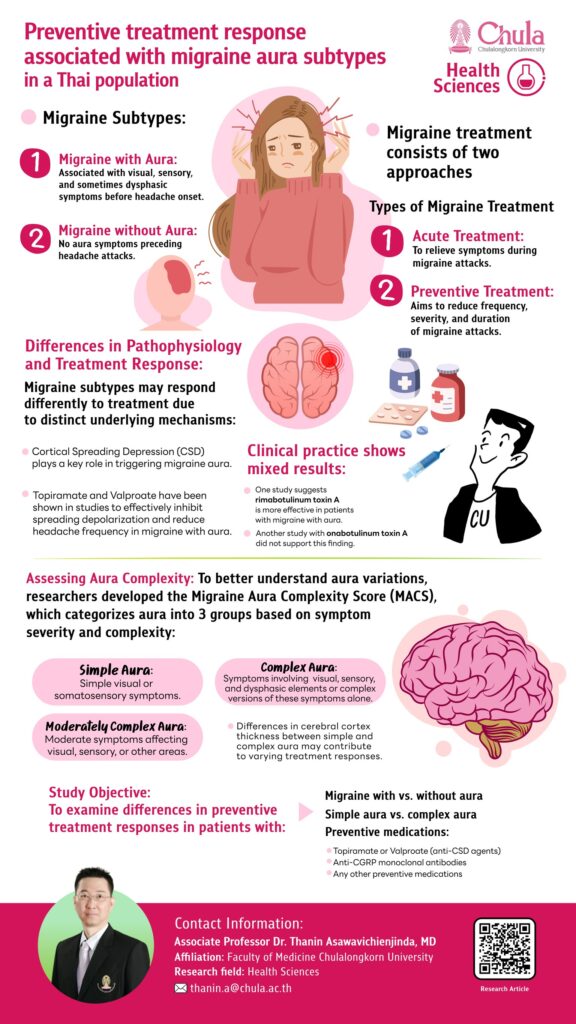
Preventive treatment response associated with migraine aura subtypes in a Thai population
Associate Professor Dr. Thanin Asawavichienjinda, MD.
Faculty of Medicine, Chulalongkorn University
Email: thanin.a@chula.ac.th
CU-Daily Research Day 34 presents “Preventive treatment response associated with migraine aura subtypes in a Thai population” by Associate Professor Dr. Thanin Asawavichienjinda, MD, Faculty of Medicine
In this fluctuating weather, many people may easily experience migraine flare-ups. Some individuals have warning signs which they can be observed. The body has a CSD mechanism that sends electrical waves to the brain. However, others experience symptoms without any prior indication, making it difficult to cope and potentially leading to extended periods of absence from work due to the severity of the pain.
.
Researchers at Chulalongkorn University are therefore studying methods to classify and observe the symptoms of migraine sufferers to find ways to prepare for this unwelcome pain. Their findings suggest that injecting Rimabotulinum Toxin A may have a good response in migraine sufferers with aura, which is a positive starting point for finding ways to alleviate the symptoms of migraine headaches in the future.
#MigraineDisorders #MigraineWithAura #Preventive #Medication #Anticonvulsants #QualityOfLife #SDGs3

Discrimination and violence against women migrant workers in Thailand
Assistant Professor Dr. Montakarn Chuemchit
College of Public Health Sciences, Chulalongkorn University
Email: montakarn.ch@chula.ac.th
CU-Daily Research Day 31 presents “Discrimination and violence against women migrant workers in Thailand” by Assistant Professor Dr. Montakarn Chuemchit, College of Public Health Sciences
One in five migrant women workers experienced discrimination during the COVID-19 pandemic.
– 63.2% experienced violence from their partners.
– 76.4% experienced violence from people who were not their partners.
Migrant women workers who experienced violence lost jobs or income during the pandemic and were more likely to face discrimination. This is linked to a higher risk of human trafficking. Therefore, this research leads to prevention strategies and action plans for migrant women workers.
#ViolenceAgainstWomen #WomenMigrantWorker #Discrimination #Thailand #SDGs5 #SDGs10 #SDGs16

Identifying new sigma receptor ligands by creating a drug library starting with N-benzylcinnamide (from Piper submultinerve) as a starting compound to treat neurodegenerative diseases such as Alzheimer’s
Dr. James M. Brimson
Faculty of Allied Health Sciences, Chulalongkorn University
Email: Jamesmichael.b@chula.ac.th
CU-Daily Research Day 30 presents “Identifying new sigma receptor ligands by creating a drug library starting with N-benzylcinnamide (from Piper submultinerve) as a starting compound to treat neurodegenerative diseases such as Alzheimer’s” by Dr. James M. Brimson, Faculty of Allied Health Sciences
As Thailand enters an aging society, one of the common diseases in the elderly is undoubtedly ‘Alzheimer’s disease,’ for which there is currently no cure that completely recovers patients.
Therefore, Chulalongkorn University researchers are studying the protection of the nervous system by stimulating the sigma-1 receptor. This involves producing the N-Benzylcinnamamide extract from natural products to develop a medication for use during treatment to alleviate Alzheimer’s symptoms, reduce issues with drug interactions when using multiple medications, or lessen the occurrence of drug side effects, ultimately aiming to improve the quality of life for patients.
#Sigma1Receptor #Sigma2Receptor #OxidativeStress #MitochondrialHealth #AutophagyRegulation #SDGs3 #SDGs12
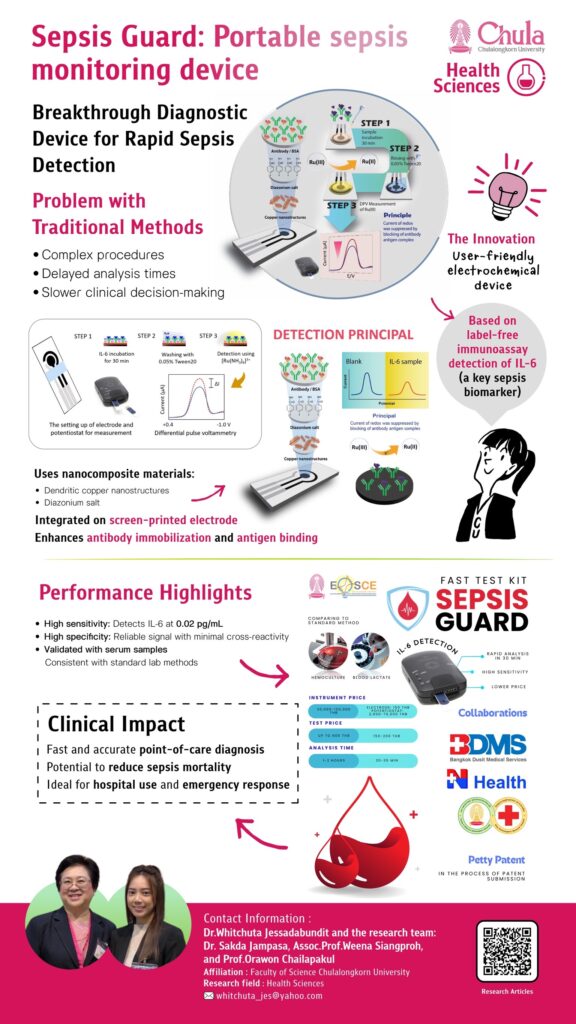
Sepsis Guard: Portable sepsis monitoring device
Professor Orawon Chailapakul, Dr.Whitchuta Jessadabundit, Dr. Sakda Jampasa, and Assoc.Prof.Weena Siangproh
Faculty of Science, Chulalongkorn University
Email: orawon.c@chula.ac.th, whitchuta_jes@yahoo.com
CU-Daily Research Day 29 presents “Sepsis Guard: Portable sepsis monitoring device” by Professor Orawon Chailapakul, Dr.Whitchuta Jessadabundit, Dr. Sakda Jampasa, and Assoc.Prof.Weena Siangproh, Faculty of Science
Sepsis, a bloodstream infection, is the number one cause of death in hospitals due to the rapid spread of disease and slow diagnostic processes. Therefore, a team of Chulalongkorn University researchers has developed a diagnostic device to detect this dangerous complication much faster.
This involves:
– Making the electrochemical detection device easier to use.
– Providing rapid test results within 30 minutes. This is achieved by detecting the IL-6 antigen using an immunoassay method. The device utilizes nanocomposite materials made from copper nanostructures on screen-printed electrodes, which significantly increases the amount of antibody binding for detection. This makes the sensor highly sensitive and specific.
– Offering an alternative diagnostic tool for both hospitals and point-of-care settings for patients with emergencies. This aims to effectively increase the chances of treatment and reduce the mortality rate.
#Interleukin-6 #DendriticCopperNanostructure #DiazoniumSalt #Immunosensor #DifferentialPulseVoltammetry #SepsisScreening #SDGs3 #SDGs12

Evaluating the benefits of emicizumab prophylaxis for haemophilia A with inhibitors: A cost-effectiveness and budget impact analysis in Thailand's upper-middle income setting
Professor Darintr Sosothikul
Faculty of Medicine, Chulalongkorn University
Email: Kanphorn.sae@gmail.com
CU-Daily Research Day 28 presents “Evaluating the benefits of emicizumab prophylaxis for haemophilia A with inhibitors: A cost-effectiveness and budget impact analysis in Thailand’s upper-middle income setting” by Professor Darintr Sosothikul, Faculty of Medicine
Treating Hemophilia A patients with inhibitors involves using Bypassing Agents (BPAs) to control bleeding. However, preventative treatment with emicizumab is an effective and cost-saving alternative to traditional treatment. This research studied and evaluated the budget impact of purchasing emicizumab for middle-income patients in Thailand, who face significant challenges in accessing effective treatment.
Nevertheless, the cost of emicizumab is much higher than BPAs, putting a strain on healthcare budgets and limiting its widespread use. Therefore, the government, healthcare providers, and manufacturers all have a role in establishing treatment policies and allocating budgets, as well as monitoring the long-term safety and effectiveness of emicizumab use. This will help gather in-depth data for developing inhibitors and adjusting treatment plans to achieve the best possible outcomes for patients.
#Thailand #CostUtilityAnalysis #Emicizumab #FactorVIII inhibitors #HaemophiliaA #HaemophiliaAWithInhibitors #Prophylaxis #SDGs3 #SDGs12

Efficacy of local anaesthetic peri‑femoral artery injection compared to subcutaneous infiltration in combination with femoral and sciatic nerve blocks for reducing thigh tourniquet‑induced hypertension during lower‑limb surgery under general anaesthesia: A randomised controlled double‑blinded trial
Dr. Chonruethai Tangkittithaworn, MD. and Dr. Wirinaree Kampitak
Faculty of Medicine, Chulalongkorn University
Email: chonruethai.tang@chula.md
CU-Daily Research Day 27 presents “Efficacy of local anaesthetic peri‑femoral artery injection compared to subcutaneous infiltration in combination with femoral and sciatic nerve blocks for reducing thigh tourniquet‑induced hypertension during lower‑limb surgery under general anaesthesia: A randomised controlled double‑blinded trial” by Dr. Chonruethai Tangkittithaworn, MD and Dr. Wirinaree Kampitak, Faculty of Medicine
Currently, orthopedic surgery commonly uses tourniquets to reduce blood loss during operations. However, using tourniquets can also lead to complications, such as discomfort in the area where the tourniquet is applied, or changes in the circulatory system like increased blood pressure and a faster heartbeat.
Chulalongkorn University’s medical researchers have always paid attention to these problems. They conducted a study to look for new treatment options. They found that injecting local anesthesia around the femoral artery, such as in the anterior thigh nerve, posterior thigh nerve, and lateral femoral base, can significantly help reduce high blood pressure caused by tourniquets.
#Hypertension #NerveBlock #SubcutaneousInfiltration #Tourniquets #SDGs3
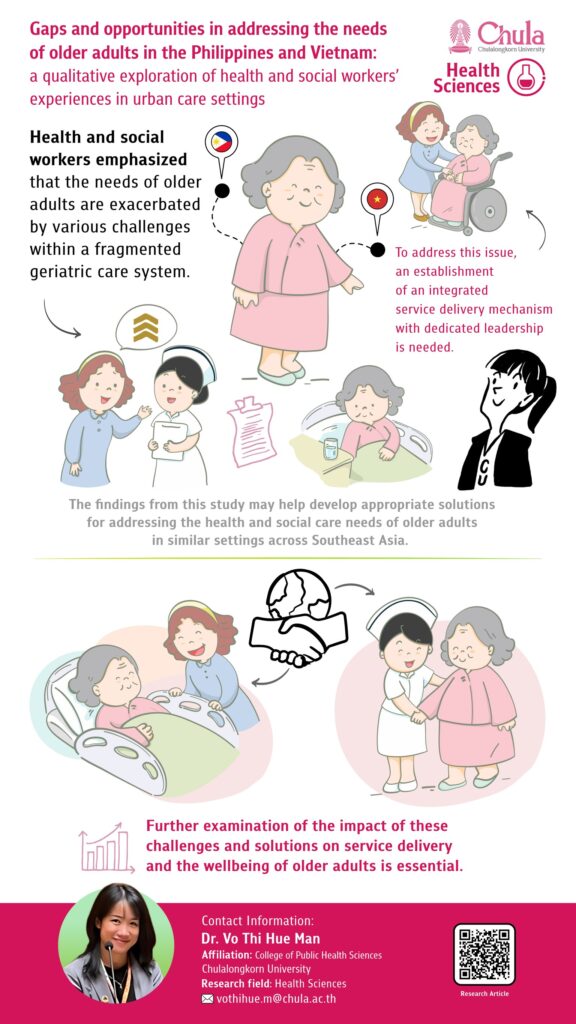
Gaps and opportunities in addressing the needs of older adults in the Philippines and Vietnam: a qualitative exploration of health and social workers’ experiences in urban care settings
Dr. Vo Thi Hue Man
College of Public Health Sciences, Chulalongkorn University
Email: vothihue.m@chula.ac.th
CU-Daily Research Day 22 presents “Gaps and opportunities in addressing the needs of older adults in the Philippines and Vietnam: a qualitative exploration of health and social workers’ experiences in urban care settings” by Dr. Vo Thi Hue Man, College of Public Health Sciences
Chulalongkorn University explored elderly care in the Philippines and Vietnam to see how their approaches to looking after older populations are similar to or different from Thailand’s. The aim was also to identify lessons that could be applied to address issues in Thailand.
The survey focused on service provision, with health and social welfare personnel highlighting the increasing needs of older adults regarding accessibility, availability, and acceptance of elderly care services. Other challenges identified included the discomfort older adults feel towards caregivers and elderly care facilities. Participants from both countries felt that strengthening collaboration towards an integrated elderly care structure, expanding training, and enhancing the capacity to care for the elderly could help bridge gaps at both individual and institutional levels. Furthermore, government policies were seen as crucial for effectively implementing these strategies.
#Philippines #Vietnam #GeriatriCare #OlderAdults #UrbanHealth #SDGs3
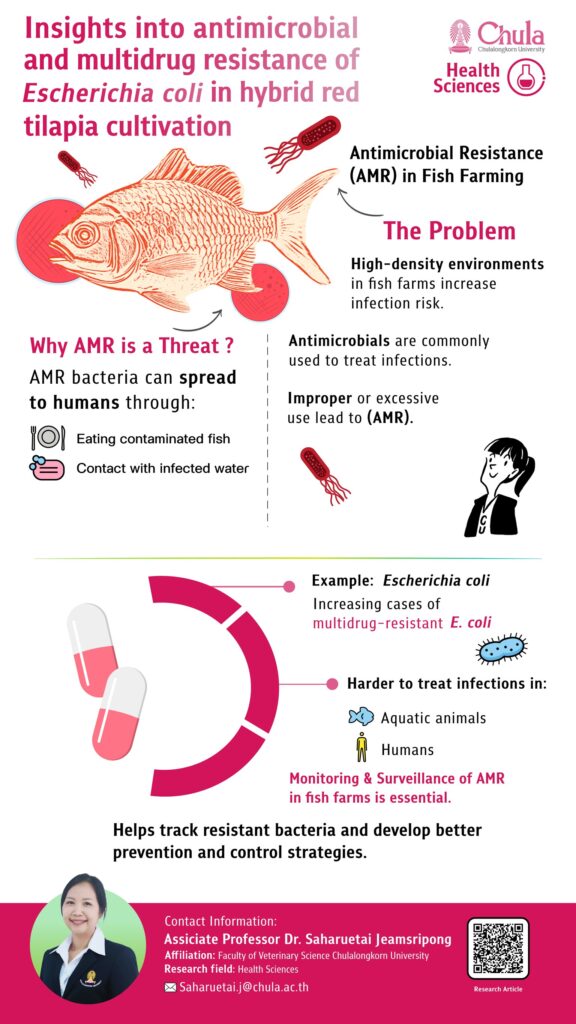
Insights into antimicrobial and multidrug resistance of Escherichia coli in hybrid red tilapia cultivation
Associate Professor Dr. Saharuetai Jeamsripong
Faculty of Veterinary Science, Chulalongkorn University
Email: Saharuetai.j@chula.ac.th
CU-Daily Research Day 18 presents “Insights into antimicrobial and multidrug resistance of Escherichia coli in hybrid red tilapia cultivation” by Assiciate Professor Dr. Saharuetai Jeamsripong, Faculty of Veterinary Science
Escherichia coli, or E. coli, is a type of bacteria that can be found in the intestines of people and animals. However, sometimes it can cause illnesses, like urinary tract infections or diarrhea.
Research on hybrid red snapper fish larvae found the spread of antibiotic-resistant bacteria, including resistance to multiple antibiotics. This resistance can be passed on to humans and the environment.
This discovery highlights the need for greater awareness, regulations on antibiotic use, and the development of new antibiotics to prepare for the spread of antibiotic-resistant E. coli.
#Aquaculture #Tilapia #AntimicrobialResistance #MultidrugResistant #Escherichiacoli #SDGs3 #SDGs12

Naked eye TB detection kit
Associate Professor Dr. Panan Ratthawongjirakul
Faculty of Allied Health Sciences, Chulalongkorn University
Email: panan_etc@yahoo.com
CU-Daily Research Day 8 presents “Naked eye TB detection kit” by Associate Professor Dr.Panan Ratthawongjirakul, Faculty of Allied Health Sciences.
The tuberculosis (TB) test kit developed for visual result reading is designed to detect the genetic material of Mycobacterium tuberculosis. The test uses Multiplex-Recombinase Polymerase Amplification (mRPA), which amplifies DNA under a single, constant temperature. The primers used are specific to the Mycobacterium tuberculosis insert sequences IS1081 and IS6110, providing results within just 30 minutes.
“MTB Strip” which allows for easy visual interpretation within 15 minutes. Additionally, a multi-drug resistant TB test kit has been developed. This kit targets specific mutations in the rpoB and katG genes, which are associated with resistance to Rifampicin and Isoniazid. The test also uses SYBR Green I to detect changes in color, and the total testing time is only 40 minutes. It’s short testing time and simple procedures, making it ideal for use in small laboratories throughout the country. Increased accessibility for the public to get TB diagnostic tests, which contributes to a wider-reaching and more effective response to TB control and prevention in Thailand.
#TB detection #MDR-TB detection #IsothermalAmplification #Tuberculosis #DetectionKit #SDGs3 #SDGs10 #SDGs12

Precision Dentistry: Advancing Towards the Future of Personalized Oral Care
Professor Dr. Thantrira Porntaveetus
Faculty of Dentistry, Chulalongkorn University
Email: thantrira.p@chula.ac.th
CU-Daily Research Day 6 presents “Precision Dentistry: Advancing Towards the Future of Personalized Oral Care” by Professor Dr. Professor Dr. Thantrira Porntaveetus, Faculty of Dentistry.
Oral health problems can stem from genetics. To provide precise and personalized oral disease treatment, Chulalongkorn University’s dental team is researching and studying “genomics,” which analyzes the risk of oral diseases from a patient’s DNA. They have also discovered the possibility of genetic transmission of oral diseases, such as enamel and dentin abnormalities, missing teeth, and periodontitis, including oral cancer.
The study of genomics and oral microbiome analysis allows dental experts to address oral diseases more accurately and predict risks with greater precision. This marks a significant step in dental care innovation, enabling the prevention, treatment, and customization of oral health care to suit each patient effectively.
#Genomics #Microbiome #Precision Dentistry #Personalized treatment #Oral health #SDGs3
Science and Technology

Rapid Test Kit on Non-Halal in Halal Food Products
Professor Suwimon Keeratipibul, Ph.D and Dr. Anat Denyingyhot
The Halal Science Center, Chulalongkorn University
Email: info.hsc.cu@gmail.com, arnat.d@chula.ac.th
CU-Daily Research Day 99 presents “Rapid Test Kit on Non-Halal in Halal Food Products” by Professor Suwimon Keeratipibul, Ph.D and Dr. Anat Denyingyhot, The Halal Science Center
For consumers of Halal food, concern about contamination from forbidden meats is paramount. Most current test kits focus on detecting pork, but data shows frequent contamination from other animal species. Chulalongkorn University researchers have therefore developed a DNA test kit that can simultaneously detect 5 types of forbidden animals: pigs, dogs, rats, cats, and monkeys, all in a single test.
With its easy-to-use method that yields results in just 90 minutes without needing a laboratory, this research helps entrepreneurs reduce laboratory testing costs by up to 10 times! This ensures the quality and purity of Halal products, enabling Muslim consumers to make informed choices about their food.
#RapidTestKit #HalalFood, #MultiplexPCR #DNAStrip #SDGs2 #SDGs12

Effect of Upwind and Downwind Directions of Right-Trapezoidal Winglet-Vortex-Generators in a Solar-Air-Heater
Associate Professor Boonchai Lertnuwat, Ph.D.
Faculty of Engineering, Chulalongkorn University
Email: Boonchai.L@chula.ac.th
CU-Daily Research Day 95 presents “Effect of Upwind and Downwind Directions of Right-Trapezoidal Winglet-Vortex-Generators in a Solar-Air-Heater” by Associate Professor Boonchai Lertnuwat, Ph.D., Faculty of Engineering
This research is a continuation of the solar drying oven design, specifically modifying the rectangular vortex generator mechanism into a trapezoidal shape to investigate heat transfer efficiency in different machine geometries.
The research found that creating a single large hole on the vortex generator significantly enhances heat transfer efficiency compared to multiple holes. This further confirms that for effective heat dissipation in solar drying ovens, the optimal ventilation mechanism involves a single large opening.
#FrictionFactor #NumberOfHoles #NusseltNumber #PerforatedWingletVortexGenerator #RightTrapezoidalWingletVortexGenerator #SolarAirHeater #SDGs7 #SDGs12
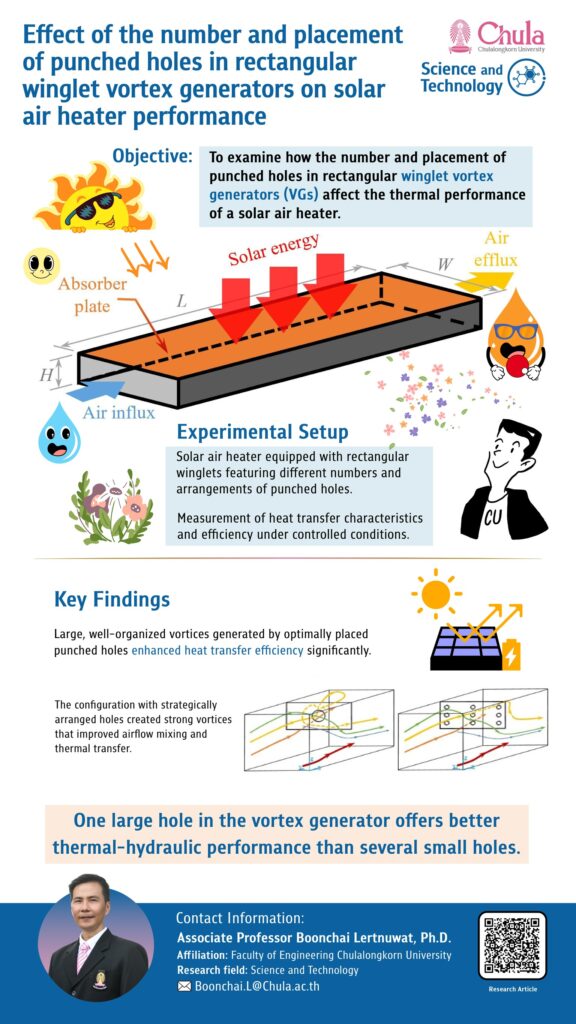
Effect of the number and placement of punched holes in rectangular winglet vortex generators on solar air heater performance
Associate Professor Boonchai Lertnuwat, Ph.D.
Faculty of Engineering, Chulalongkorn University
Email: Boonchai.L@chula.ac.th
CU-Daily Research Day 94 presents “Effect of the number and placement of punched holes in rectangular winglet vortex generators on solar air heater performance” by Associate Professor Boonchai Lertnuwat, Ph.D., Faculty of Engineering
Chulalongkorn University researchers designed a solar drying oven, experimenting with a special mechanism: a rectangular winglet vortex generator, to enhance heat transfer efficiency.
This research found that creating a single large hole on the vortex generator significantly enhances heat transfer efficiency compared to multiple holes. This finding confirms that for effective heat dissipation in solar drying ovens, the optimal ventilation mechanism involves a single large opening.
#FrictionFactor #Nusselt Number #PerforatedWingletVortexGenerator #RectangularWingletVortexGenerator #SolarAirHeater #SDGs7 #SDGs12

Intelligent monitoring of tool wear and quality control of roughness with roundness in CNC turning
Professor Dr. Somkiat Tangjitsitcharoen
Faculty of Engineering, Chulalongkorn University
Email: somkiat.ta@eng.chula.ac.th
CU-Daily Research Day 89 presents “Intelligent monitoring of tool wear and quality control of roughness with roundness in CNC turning” by Professor Dr. Somkiat Tangjitsitcharoen, Faculty of Engineering
Turning is a crucial manufacturing process in the industrial world. Creating complex parts requires high precision to achieve smooth and efficient surfaces.
Chulalongkorn University researchers are therefore advancing CNC (Computer Numerical Control) turning technology by developing a real-time cutting force analysis system. This system accurately predicts tool wear, surface roughness, and the roundness of the workpiece. This innovation will significantly reduce waste, rework, and production costs, while also massively increasing production rates.
#CNCturning #CuttingForces #WaveletTransform #ToolWear #Roughness #Roundness #SDGs9 #TRL5
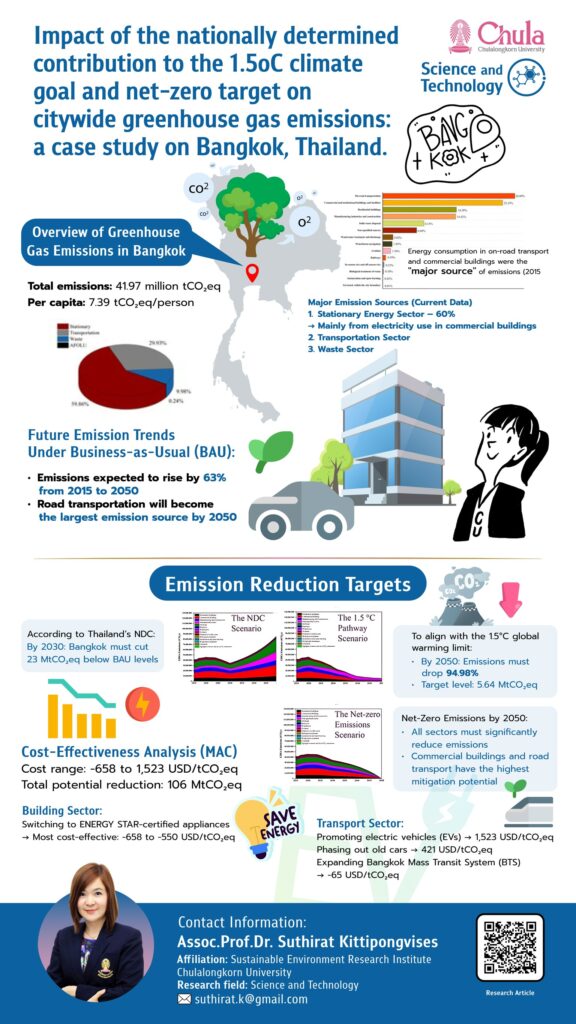
Impact of the nationally determined contribution to the 1.5 oC climate goal and net-zero target on citywide greenhouse gas emissions: a case study on Bangkok, Thailand.
Associate Professor Dr. Suthirat Kittipongvises
Sustainable Environment Research Institute, Chulalongkorn University
Email: suthirat.k@gmail.com
CU-Daily Research Day 83 presents “Impact of the nationally determined contribution to the 1.5oC climate goal and net-zero target on citywide greenhouse gas emissions: a case study on Bangkok, Thailand.” by Associate Professor Dr. Suthirat Kittipongvises, Sustainable Environment Research Institute
‘Bangkok’ a key economic city in Thailand, faces a major challenge as a massive emitter of greenhouse gases. Researchers at Chulalongkorn University have assessed the current and future situation, proposing crucial strategies to achieve national and global climate targets.
The study found that Bangkok emits a large amount of greenhouse gases, particularly from commercial buildings and transportation. Without any intervention, emissions are projected to soar by 63% by 2050. However, to meet national targets and the 1.5°C goal, we must achieve substantial emission reductions. This is possible through effective and cost-efficient measures such as using energy-efficient appliances and promoting electric vehicles (EVs). This research highlights the urgent need for Bangkok to take action for a sustainable and pollution-free future.
#City #Climate Change #Bangkok #Nationally Determined Contribution, Mitigation Action #Net-zero emission #SDGs11 #SDGs13
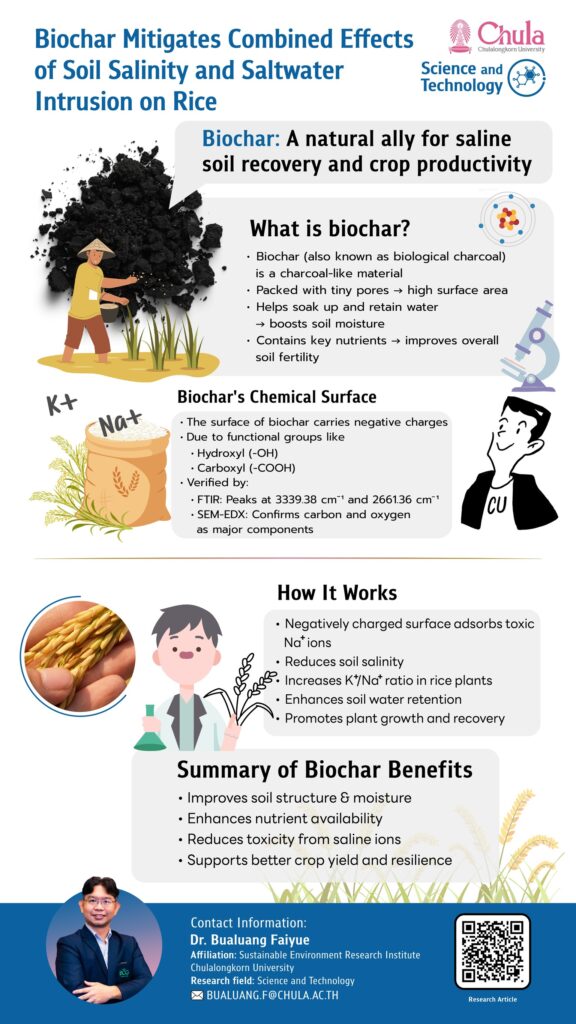
Biochar Mitigates Combined Effects of Soil Salinity and Saltwater Intrusion on Rice
Dr. Bualuang Faiyue
Sustainable Environment Research Institute, Chulalongkorn University
Email: Bualuang.f@chula.ac.th
CU-Daily Research Day 81 presents “Biochar Mitigates Combined Effects of Soil Salinity and Saltwater Intrusion on Rice” by Dr. Bualuang Faiyue, Sustainable Environment Research Institute
Saline soil refers to agricultural land contaminated with high salt concentrations, which poses a significant problem for farmers. The salt accumulates in rice plants, preventing them from growing fully and leading to substantial crop losses for farmers every year. Researchers at Chulalongkorn University are addressing this issue by introducing biochar.
The research found that biochar has special properties that help absorb toxic sodium ions (Na+) and increase the K+/Na+ ion ratio in rice plants, thereby improving their survival rate. Biochar thus presents a new alternative that enhances the growth potential of rice cultivated in areas affected by saltwater-induced soil salinity.
#SalineSoil #Biochar #SodiumAdsorption #SoilProperties #RiceYield #SDGs12
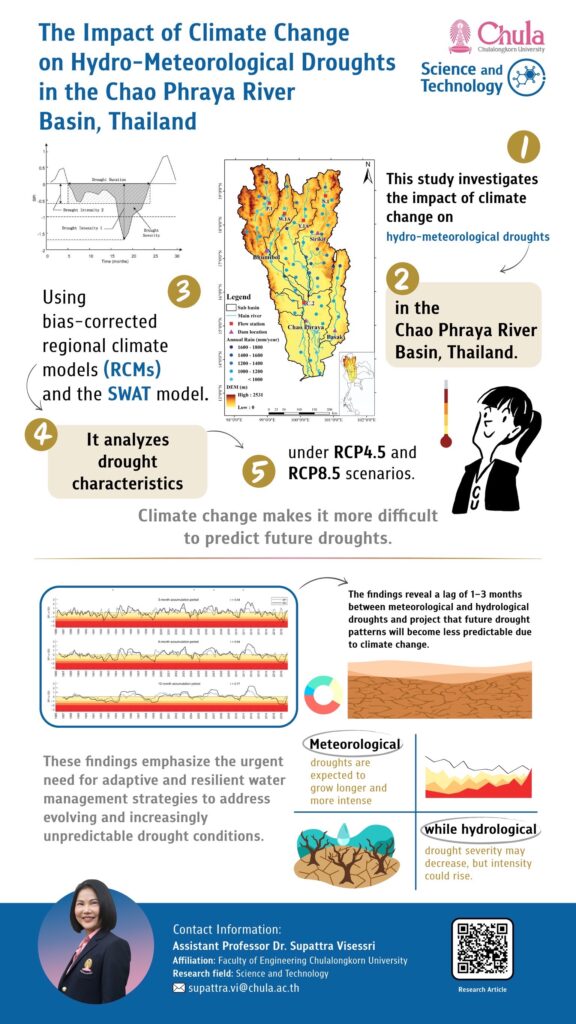
The Impact of Climate Change on Hydro-Meteorological Droughts in the Chao Phraya River Basin, Thailand
Assistant Professor Dr. Supattra Visessri
Faculty of Engineering, Chulalongkorn University
Email: supattra.vi@chula.ac.th
CU-Daily Research Day 78 presents “The Impact of Climate Change on Hydro-Meteorological Droughts in the Chao Phraya River Basin, Thailand” by Assistant Professor Dr. Supattra Visessri, Faculty of Engineering
On World Day to Combat Desertification and Drought, Chulalongkorn University presents research on drought issues aimed at preventing and coping with increasingly unpredictable climate variability in the future.
The study found that meteorological droughts (low rainfall) are likely to become more severe and prolonged, while hydrological droughts (decreased water in reservoirs) may follow within 1-3 months. This finding emphasizes the urgent need for Thailand to have flexible and adaptable water management strategies to cope with changing drought conditions and protect this vital resource in the long term.
#ChaoPhraya #Thailand #Drought #SPI #SSI #SEACLID/CORDEX-SEA #SWAT #SDGs11
#SDGs13
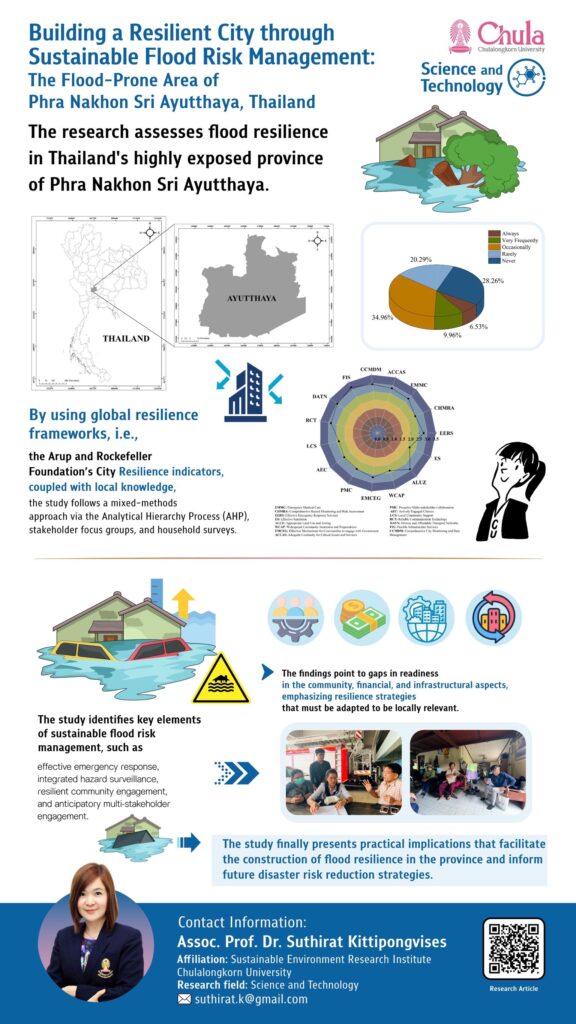
Building a Resilient City through Sustainable Flood Risk Management: The Flood-Prone Area of Phra Nakhon Sri Ayutthaya, Thailand
Associate Professor Dr. Suthirat Kittipongvises
Sustainable Environment Research Institute, Chulalongkorn University
Email: suthirat.k@gmail.com
CU-Daily Research Day 77 present “Building a Resilient City through Sustainable Flood Risk Management: The Flood-Prone Area of Phra Nakhon Sri Ayutthaya, Thailand” by Associate Professor Dr. Suthirat Kittipongvises, Sustainable Environment Research Institute
Ayutthaya, a World Heritage city where three rivers converge, is facing increasing challenges from severe and frequent floods. Researchers at Chulalongkorn University are seeking solutions by studying key factors that enable the city to recover better from flooding.
By using an international assessment framework combined with data and insights from the community, effective guidelines for emergency response preparedness, disaster surveillance, and community participation have been developed. This leads to policy recommendations that strengthen disaster response and flood protection in Ayutthaya province and similar cities, preparing them to cope with long-term flooding issues.
#FloodResilience #DisasterRiskReduction #EmergencyResponse #CommunityPreparedness #SDGs11 #SDGs13
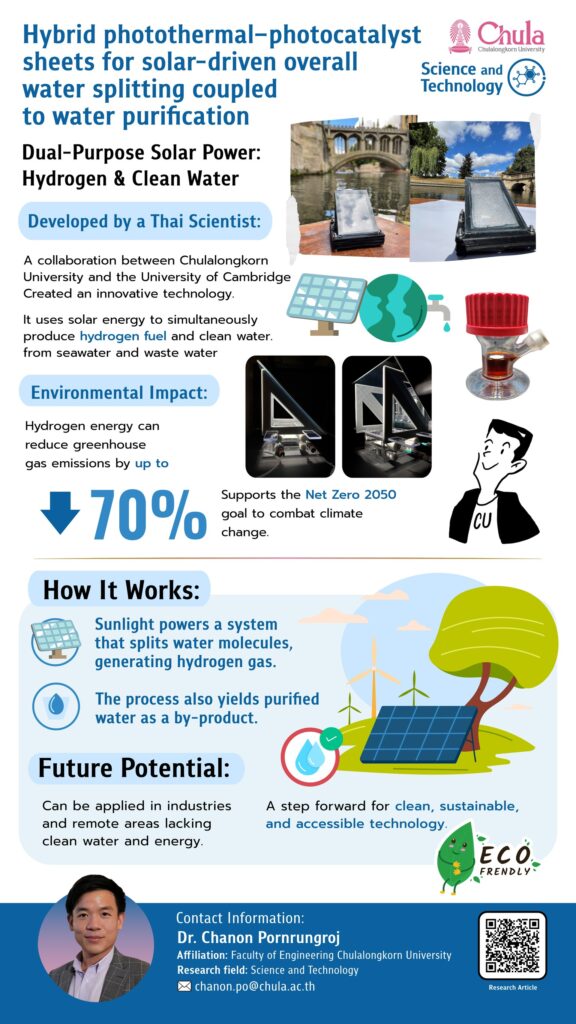
Hybrid photothermal–photocatalyst sheets for solar-driven overall water splitting coupled to water purification
Dr. Chanon Pornrungroj
Faculty of Engineering, Chulalongkorn University
Email: chanon.po@chula.ac.th
CU-Daily Research Day 71 present “Hybrid photothermal–photocatalyst sheets for solar-driven overall water splitting coupled to water purification” by Dr. Chanon Pornrungroj, Faculty of Engineering
Prepare to move towards the Net Zero goal with research from Chulalongkorn University that transforms water into clean energy using solar power. Good water, wastewater, natural water, and water from industrial processes all become hydrogen and high-quality potable clean water.
This research utilizes solar heat to evaporate water and condense it back into clean water. Concurrently, UV light helps split water into hydrogen and oxygen. This differs from traditional hydrogen production methods which are high-cost, low-efficiency, and require extensive space. This represents a new approach to developing environmentally friendly, low-cost, and high-quality alternative energy.
#hydrogeneconomy #solarenergy #SDGs6 #SDGs7 #SDGs14
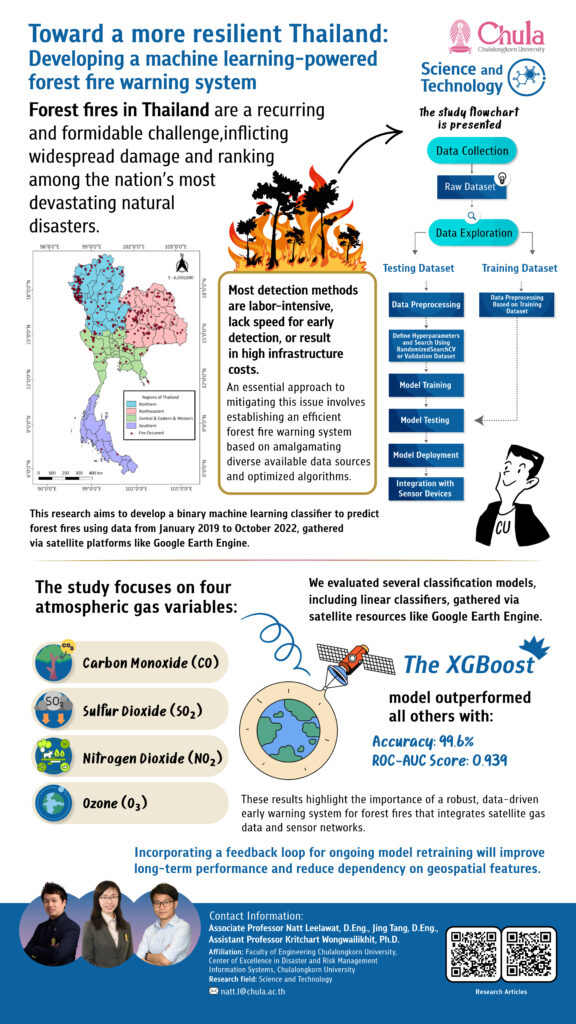
Toward a more resilient Thailand: Developing a machine learning-powered forest fire warning system
Associate Professor Natt Leelawat, D.Eng., Jing Tang, D.Eng., and Assistant Professor Kritchart Wongwailikhit, Ph.D.
Faculty of Engineering, Chulalongkorn University
Email: natt.l@chula.ac.th
CU-Daily Research Day 69 presents “Toward a more resilient Thailand: Developing a machine learning-powered forest fire warning system” by Associate Professor Natt Leelawat, D.Eng., Jing Tang, D.Eng., and Assistant Professor Kritchart Wongwailikhit, Ph.D., Faculty of Engineering
Wildfires are an ongoing problem that severely impacts the environment and local communities in Thailand. Traditional detection methods rely on human labor, which is slow and costly. Researchers at Chulalongkorn University have therefore invented a fire warning method using high-precision technology that is suitable for Thailand’s environment.
This research developed a model by analyzing satellite data to read key gas values that contribute to wildfires, achieving an accuracy of 99.6%. This allows for the rapid and precise prediction of wildfires, leading to quick and accurate warnings. This is an innovation ready for further development that will significantly reduce damages.
#FloodResilience #DisasterRiskReduction #EmergencyResponse #CommunityPreparedness #SDGs11 #SDGs15

Drought-Induced Agricultural and Food Security Challenges in the Baribo Basin, Cambodia
Assistant Professor Dr. Supattra Visessri
Faculty of Engineering, Chulalongkorn University
Email: supattra.vi@chula.ac.th
CU-Daily Research Day 68 presents “Drought-Induced Agricultural and Food Security Challenges in the Baribo Basin, Cambodia” by Assistant Professor Dr. Supattra Visessri, Faculty of Engineering
‘The Baribo River Basin,’ a crucial food production area in Cambodia, is facing recurrent drought problems. This is evident from historical drought statistics during 1993–1994 and 2002–2006, which were severe and caused immense damage to rice cultivation areas.
Based on these statistics, researchers at Chulalongkorn University can predict that the next drought will directly impact the country’s food security, as drought is correlated with agricultural damage. This research emphasizes the necessity for effective drought management for sustainable food security.
#TonleSap #MeteorologicalDrought #AgriculturalDrought #DroughtIndex #FoodSecurity #SDGs12 #SDGs13
Silicon Dioxide Gel for Extracting and Capturing Small-Sized Microplastics
Assistant Professor Dr. Kamonwan Pacaphol
Faculty of Science, Chulalongkorn University
Email: kamonwan.p@chula.ac.th
CU-Daily Research Day 66 presents “Silicon Dioxide Gel for Extracting and Capturing Small-Sized Microplastics” by Assistant Professor Dr. Kamonwan Pacaphol, Faculty of Science
Microplastics are currently considered as the smallest and most challenging waste to manage, easily contaminating water sources, farmlands, and human food. Researchers at Chulalongkorn University have therefore extracted tetraethyl orthosilicate (TEOS), which helps capture these microplastics in a gel form (silicon dioxide gel: SiO₂ gel).
The research results show that this microplastic-capturing gel can trap microplastics with an efficiency of 95-100%. This aids in the process of analyzing plastic types and accurately processing the detection of microplastic contamination in water sources, ultimately helping to find ways to address the impacts on human and aquatic animal health.
#MicroplasticExtraction #SmallMicroplasticParticles #Sol-Gel Technique #SiliconDioxideGel #Silane #SDGs14

Rice husk biochar ameliorates saline-sodic stress in rice through sodium adsorption and improving soil properties
Dr. Bualuang Faiyue
Sustainable Environment Research Institute, Chulalongkorn University
Email: Bualuang.f@chula.ac.th
CU-Daily Research Day 64 presents “Rice husk biochar ameliorates saline-sodic stress in rice through sodium adsorption and improving soil properties” by Dr. Bualuang Faiyue, Sustainable Environment Research Institute.
Saline soil problems lead to an imbalance of plant nutrients, causing agricultural yields to grow slowly, become stunted, and potentially die. This also contributes to soil degradation and erosion. These issues have a massive impact on the agricultural sector.
Researchers at Chulalongkorn University have therefore devised a method to dispose of agricultural waste using the ‘Thep Thicha’ incinerator. This incinerator meets international standards, does not cause air pollution, and produces high-quality biochar. This biochar helps improve soil quality, making it ready for cultivation, and creates a valuable and sustainable resource utilization cycle that benefits the environment.
#Biochar #SalineSoil #HeavyMetals #FoodSecurity #GlobalWarming #SDGs2 #SDGs12

Vulnerability of drinking water supply and respondent’s perception on the quality of water supply in Dhaka City, Bangladesh
Associate Professor Dr. Suthirat Kittipongvises
Sustainable Environment Research Institute, Chulalongkorn University
Email: suthirat.k@gmail.com
CU-Daily Research Day 60 presents “Vulnerability of drinking water supply and respondent’s perception on the quality of water supply in Dhaka City, Bangladesh” by Associate Professor Dr. Suthirat Kittipongvises, Sustainable Environment Research Institute
‘Dhaka’ The capital of Bangladesh, is ranked as one of the most polluted and populous cities in the world. It also faces severe water scarcity, particularly concerning groundwater, as surface water pollution is prevalent in many areas.
Researchers at Chulalongkorn University have found that increasing population and rising temperatures contribute to the decline of groundwater levels. This issue has led residents to show interest in paying for improvements in drinking water services. This research will lead to the proposal of an economic model and drive the implementation of sustainable water management policies in Dhaka.
#EnvironmentalSustainability #GlobalClimateChange #WaterResourcesManagement #SDGs 6 #SDGs13

34-kDa salivary protein enhances duck Tembusu virus infectivity in the salivary glands of Aedes albopictus by modulating the innate immune response
Associate professor Dr. Sonthaya Tiawsirisup and Dr. Chalida Sri-in
Faculty of Veterinary Science, Chulalongkorn University
Email: sonthaya.t@chula.ac.th, chalida.s@chula.ac.th
CU-Daily Research Day 57 presents “34-kDa salivary protein enhances duck Tembusu virus infectivity in the salivary glands of Aedes albopictus by modulating the innate immune response” by Associate professor Dr. Sonthaya Tiawsirisup and Dr. Chalida Sri-in, Faculty of Veterinary Science
Ducks Tembusu virus is transmitted by mosquitoes like Culex and Aedes, affecting the ducks’ nervous system and egg production, leading to significant damage in the duck farming industry. Researchers from Chulalongkorn University’s Faculty of Veterinary Science are therefore studying key substances in mosquito salivary glands to explore potential ways to control this epidemic.
The study found that a 34 kDa protein in the salivary glands may be important in promoting viral infection. In the future, this could lead to the development of more effective methods to reduce the virus’s spread than chemical mosquito repellents.
#DuckTembusuVirus #Ae.albopictus #34-kDaSalivaryProtein #SDGs9 #SDGs12
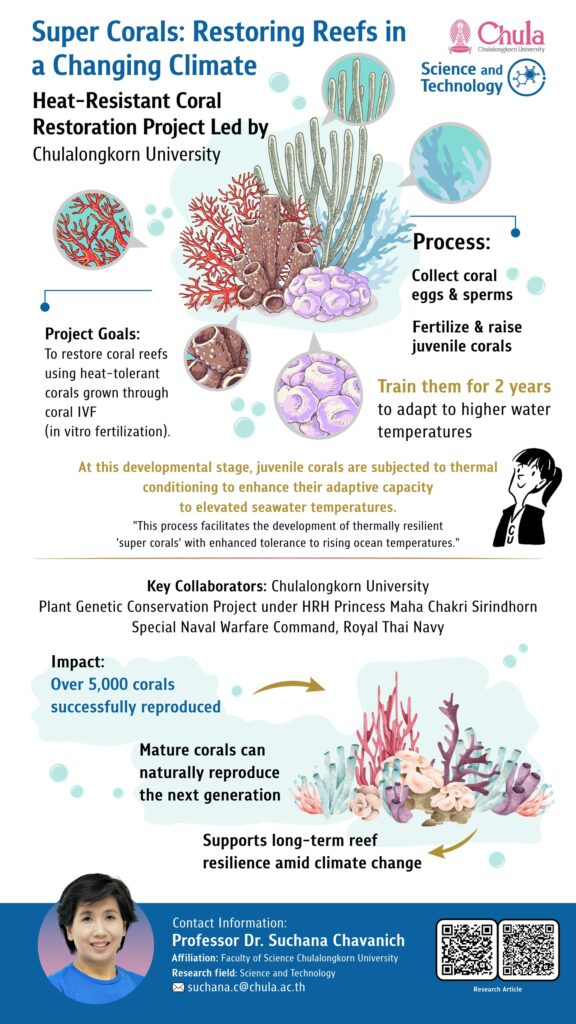
Super Corals: Restoring Reefs in a Changing Climate
Professor Dr. Suchana Chavanich
Faculty of Science, Chulalongkorn University
Email: suchana.c@chula.ac.th
CU-Daily Research Day 53 presents “Super Corals: Restoring Reefs in a Changing Climate” by Professor Dr. Suchana Chavanich, Faculty of Science
The current global environmental situation has escalated from “global warming” to “global boiling.” This affects not only the atmosphere but also the rising temperatures of ocean water, which could lead to the disappearance of remaining coral reefs in less than 30 years.
Researchers at Chulalongkorn University have been conducting sexual reproduction-based coral cultivation for two years. The corals are trained to adapt to increasing temperatures. The findings show that coral larvae produced through artificial fertilization can grow into parent colonies capable of reproducing future generations on their own.
#SuperCorals #CoralRestoration #IVF #SDGs13 #SDGs14

Uncovering and understanding hidden biodiversity in Thailand and other tropical countries
Associate Professor Dr. Buntika A. Butcher
Faculty of Science, Chulalongkorn University
Email: buntika.a@chula.ac.th
CU-Daily Research Day 52 presents “Uncovering and understanding hidden biodiversity in Thailand and other tropical countries” by Associate Professor Dr. Buntika A. Butcher, Faculty of Science
Welcoming “International Day for Biological Diversity” with a study of the diversity of parasitoid wasps – insects in the same group as bees, ants, and wasps – that naturally control the populations of other insects in land ecosystems. This acts as a natural way to get rid of plant pests. Samples were collected from three areas: Doi Phu Kha National Park, Khao Yai National Park, and Sakaerat Environmental Research Station.
The study found that parasitoid wasps, especially the Ichneumonoidea superfamily, are one of the most diverse groups in the animal kingdom. Wasps in the families Scelionidae, Ichneumonidae, Eulophidae, Braconidae, and Platygastridae were the most commonly found. Importantly, most of these haven’t been studied or scientifically named yet, indicating that there are still many parasitoid wasp species waiting to be discovered and researched.
#ParasitoidWasps #Biodiversity #Systematics #DNABarcoding #SDGs15

Bioactives in rice leaf tea: processing and brewing techniques
Professor Dr. Supaart Sirikantaramas
Faculty of Science, Chulalongkorn University
Email: supaart.s@chula.ac.th
CU-Daily Research Day 51 presents “Bioactives in rice leaf tea: processing and brewing techniques” by Professor Dr. Supaart Sirikantaramas, Faculty of Science
Thai jasmine rice is renowned for its fragrant grains, unique texture, and softness. Additionally, it can be used to produce antioxidant-rich herbal tea. On International Tea Day, Chulalongkorn University presents research on the production of young jasmine rice leaf tea, comparing the drying processes of freeze-drying and sun-drying.
The research found that 7-day-old young jasmine rice leaves are rich in bioactive compounds. The sun-drying method resulted in higher levels of antioxidant flavonoids and more fragrant volatile compounds compared to freeze-dried young jasmine rice leaves. This suggests potential for future development into a healthy beverage.
#FlavonoidProfiling #FlavoneCGlycosides #JasmineRiceSeedlingLeafTea #Odor #SDGs2

Shophouse2Go! An easy way to renovate old shophouses for everyone
Assistant Professor Dr. Chomchon Fusinpaiboon
Faculty of Architecture, Chulalongkorn University
Email: chomchon.f@chula.ac.th
CU-Daily Research Day 47 presents “Shophouse2Go! An easy way to renovate old shophouses for everyone” by Assistant Professor Dr. Chomchon Fusinpaiboon, Faculty of Architecture
During the 1960s to 1970s, a large number of shophouses were built in Bangkok with a standardized design. Currently, these buildings are deteriorating or underutilized, despite their proximity to the city center. Architects at Chulalongkorn University are therefore looking at these ‘buildings of the past’ to transform them into ‘new buildings of the future,’ offering a fresh housing option for city dwellers.
Renovating shophouses provides Bangkok’s population with suitable housing and business options that align with modern lifestyles and improve the quality of urban life. This approach reduces demolition and supports urban regeneration. Furthermore, this strategy can help revitalize the city’s common heritage and decrease its carbon footprint.
#Shophouse #Renovation #SDGs11

CelluDent: Bio-based hemostatic sponge
Professor Dr. Voravee Hoven, Assistant Professor Vorapat Trachoo, D.D.S, M.D., and Dr. Yuwaporn Pinyakit
Faculty of Science, Chulalongkorn University
Email: vipavee.p@chula.ac.th, pinyakit.y@gmail.com
CU-Daily Research Day 42 presents “CelluDent: Bio-based hemostatic sponge” by Professor Dr. Voravee Hoven, Assistant Professor Vorapat Trachoo, D.D.S, M.D., and Dr. Yuwaporn Pinyakit, Faculty of Science
Chulalongkorn University has an innovation that helps absorb blood and stimulate blood clotting. It is flexible and can be shaped to fit the characteristics of the wound.
This hemostatic material, in the form of a sponge developed from natural polymers, was created for use in dental hemostasis. It can stop bleeding within 3 minutes and is suitable for deep wounds, such as tooth sockets. It reduces the problems caused by traditional materials with high acidity and damaged proteins. Researchers at Chulalongkorn University hope that this innovation will be used for general patients and patients with bleeding disorders.
#Hemostat #NaturalPolymer #Sponge #Dentistry #Cellulose #SDGs3
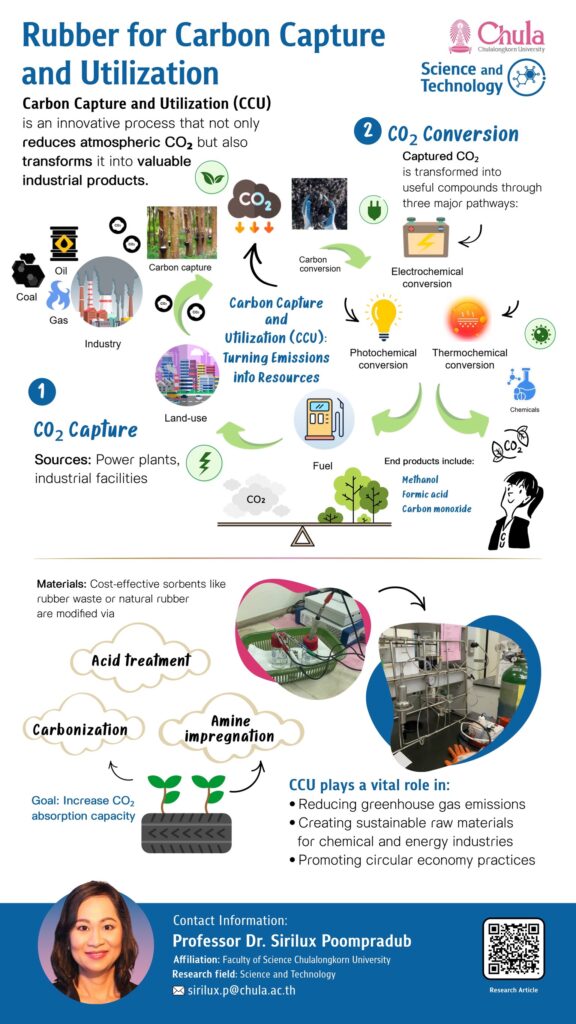
Rubber for Carbon Capture and Utilization
Professor Dr. Sirilux Poompradub
Faculty of Science, Chulalongkorn University
Email: sirilux.p@chula.ac.th
CU-Daily Research Day 38 presents “Rubber for Carbon Capture and Utilization” by Professor Dr. Sirilux Poompradub, Faculty of Science
The problems of climate change and the increase in atmospheric carbon dioxide (CO₂) stem from the burning of fossil fuels in industry, transportation, and energy production, severely impacting the environment. The development of Carbon Capture and Utilization (CCU) processes is therefore a crucial approach to reducing CO₂ and transforming this gas into a valuable resource.
Researchers at Chulalongkorn University are turning waste into value by using natural and modified rubber waste to capture CO₂ and convert it into value-added chemicals. This creates economic benefits and contributes to sustainable environmental conservation.
#CarbonCapture #CarbonUtilization #Rubber #SDGs12 #SDGs13
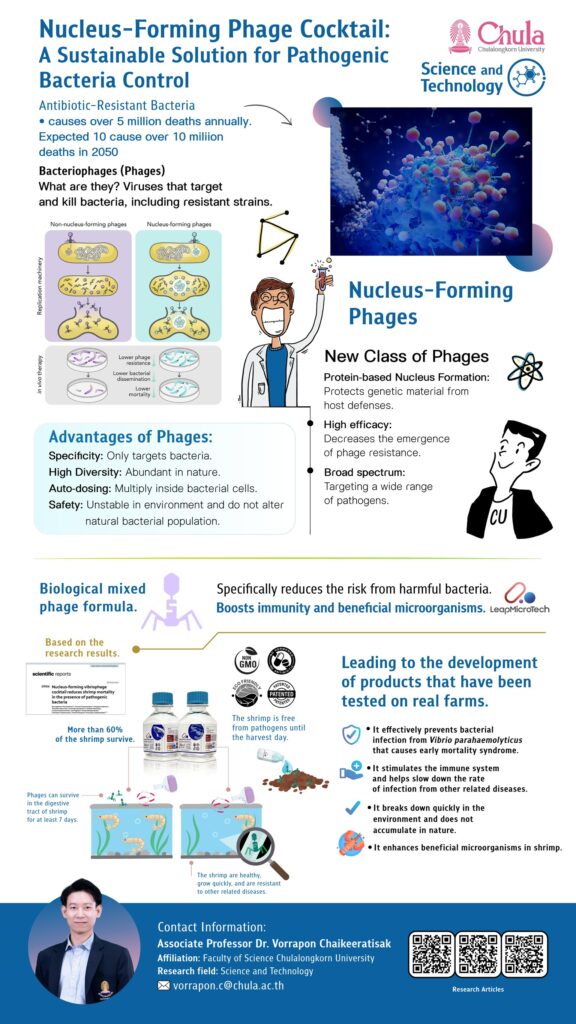
Nucleus-Forming Phage Cocktail: A Sustainable Solution for Pathogenic Bacteria Control
Associate Professor Dr. Vorrapon Chaikeeratisak
Faculty of Science, Chulalongkorn University
Email: vorrapon.c@chula.ac.th
CU-Daily Research Day 37 presents “Nucleus-Forming Phage Cocktail: A Sustainable Solution for Pathogenic Bacteria Control” by Associate Professor Dr. Vorrapon Chaikeeratisak, Faculty of Science
The uncontrolled and improper use of antibiotics has led to an increase in antibiotic-resistant bacteria. Additionally, the discovery of new antibiotics has declined in recent years. Consequently, scientists worldwide are developing “Bacteriophages” or “Phages” as a replacement for antibiotics. Phages are naturally occurring viruses that are harmless to humans and other living organisms and can effectively kill antibiotic-resistant strains of bacteria.
Researchers at Chulalongkorn University have applied this knowledge to design phage cocktail formulations for controlling pathogenic bacteria in Thailand’s economically important aquatic animals, such as shrimp. Their findings indicate that these formulations can reduce mortality rates caused by pathogenic bacteria. This research could potentially lead to the design of highly effective phage cocktails for managing other types of pathogenic bacteria in humans in the future.
#PhageTherapy #Bacteriophage #PhageCocktail #Superbugs #emergingPathogens #SDGs3 #SDGs12

SilkLife: Transforming Healthcare with Cutting-Edge Biomaterial Solutions
Associate professor Dr. Juthamas Ratanavaraporn and Dr. Saran Keeratihattayakorn
Faculty of Engineering, Chulalongkorn University
Email: juthamas.r@chula.ac.th, saran.ke@chula.ac.th
CU-Daily Research Day 26 presents “SilkLife: Transforming Healthcare with Cutting-Edge Biomaterial Solutions” by Associate professor Dr. Juthamas Ratanavaraporn and Dr. Saran Keeratihattayakorn, Faculty of Engineering
Thai silk is stepping into medical innovation by becoming a biomaterial. This involves extracting fibroin protein from Thai silk to obtain a sterile protein solution that can be used in medicine, especially in drug delivery and controlled release systems, as well as tissue engineering. It has received numerous standard certifications in Thailand and is ready to be launched and further developed for commercialization businesses.
The Chulalongkorn University research team focuses on scaling up their research for industrial-level medical production. This ranges from controlling the quality of mulberry cultivation and raising contaminant-free silkworms to inventing innovative methods for extracting sterile silk fibroin solutions. The goal is to develop advanced medical products such as drug-delivering patches, injectable hydrogels, and cosmetic products.
#ThaiSilkFibroinSolution #MedicalProducts #UpscaleProduction #SDGs3 #SDGs12

Passive design strategies for occupants’ comfort in children’s development center using computer-based simulation
Associate Professor Phanchalath Suriyothin and Assistant Professor Dr. Apiparn Borisuit
Faculty of Architecture, Chulalongkorn University
Email: phanchalath.s@chula.ac.th, apiparn.b@chula.ac.th
CU-Daily Research Day 24 presents “Passive design strategies for occupants’ comfort in children’s development center using computer-based simulation by Associate Professor Phanchalath Suriyothin and Assistant Professor Dr. Apiparn Borisuit, Faculty of Architecture
“April is the hottest month of the year, often accompanied by the highest electricity bills. This is because households and even daycare centers run fans and air conditioners almost all day long to alleviate the heat, especially during the hottest part of the day when children need to rest comfortably.
Therefore, Chulalongkorn University researchers are proposing improvements to comfort conditions and ventilation inside daycare centers, based on their existing structures. They used computer simulations of the environment and buildings and applied natural design strategies (passive design strategies) such as building orientation, shading devices, insulation installation, and increased ventilation to enhance indoor comfort. The findings show that buildings with insulation, along with shading devices and nighttime window ventilation, can meet the required standards. This study can serve as an effective model for improving other daycare center buildings.
#Thermal comfort #Thailand #PassiveDesignStrategies #ChildDevelopmentCenter #SDGs11
Bio Responsive Block: The Performance of Bio Waste Material with reduced Environmental Impact
Dr. Runda Aduldejcharas
Faculty of Architecture, Chulalongkorn University
Email: runda.a@chula.ac.th
CU-Daily Research Day 23 presents “Bio Responsive Block: The Performance of Bio Waste Material with reduced Environmental Impact” by Dr. Runda Aduldejcharas, Faculty of Architecture
Mussels are commonly found in the community. This area is a fishing hub with a large amount of mussel shell waste, which causes pollution problems in the community. These shells can’t be disposed of using traditional methods, and there isn’t a designated area for discarding them. What are the appropriate methods for the disposal and sustainable conversion for bio-waste shell into a valuable resource?
Chula researchers are therefore looking for ways to process these shells into something that can create value for the community in the future. They analyzed the material’s performance by burning mussel shells at temperatures of 400, 800, and 1200 °C using an X-ray diffractometer (XRD) and an X-ray fluorescence (XRF) spectrometer to analyze the chemical composition. They found that burning the shells at different temperatures changes the material’s chemical structure at each temperature level. This material can be recycled and reused for beneficial purposes, such as increasing sustainability or creating a more livable environment in the community.
#BioWasteMaterial #CalciumCarbonate #MechanicalProperties #CommunityEnvironment #Sustainability #SDGs3 #SDGs8 #SDGs9 #SDGs11 #SDGs12 #SDGs14 #SDGs15
Bamboo (Dendrocalamus Asper) as an Eco-Friendly Sustainable Material: Optimising Mechanical Properties and Enhancing Load-Bearing Capacity for Environmental Architectural Design
Dr. Runda Aduldejcharas
Faculty of Architecture, Chulalongkorn University
Email: runda.a@chula.ac.th
CU-Daily Research Day 20 presents “Bamboo (Dendrocalamus Asper) as an Eco-Friendly Sustainable Material: Optimising Mechanical Properties and Enhancing Load-Bearing Capacity for Environmental Architectural Design” by Dr. Runda Aduldejcharas, Faculty of Architecture
Bamboo has been used for a long time and is very common in building homes because it’s easy to find, grows quickly, is durable, strong, and can handle all kinds of weather, especially hot and humid climates.
This research supports using bamboo in different types of buildings because it’s a material that can be found locally, it can hold weight well, and it’s good for the environment.
#Sustainable #LowCarbon #ECOfriendly #ฺBuildingMaterials #SDGs8 #SDGs11 #SDGs12
Challenges of Applying Simplified LCA Tools in Sustainable Design Pedagogy
Dr. Suphichaya Suppipat
Faculty of Architecture, Chulalongkorn University
Email: Suphichaya.S@chula.ac.th
CU-Daily Research Day 14 presents “Challenges of Applying Simplified LCA Tools in Sustainable Design Pedagogy” by Dr. Suphichaya Suppipat, Faculty of Architecture
Good product design should consider sustainability. New designers should have strong analytical thinking skills from their classroom experience. As a Chulalongkorn University professor, I am planning and designing a learning process about “Life Cycle Assessment (LCA)” to cultivate a sustainable design process in students from the very beginning.
Understanding the Life Cycle Assessment helps students grasp systematic design principles and become aware of environmental issues. This prepares them before entering the professional design field, where they can contribute to the positive environmental impact in the future.
#Sustainability #Ecodesign #LifeCycleAssessment #SustainableInnovation #SustainableDesignPedagogy #SDGs9
Development and promotion of low-carbon tourism and environmental network in Koh Si Chang in line with the Blue Economy
Dr. Wilailuk Niyommaneerat
Sustainable Environment Research Institute, Chulalongkorn University
Email: wilailuk.n@chula.ac.th
CU-Daily Research Day 12 presents “Development and promotion of low-carbon tourism and environmental network in Koh Si Chang in line with the Blue Economy” by Dr. Wilailuk Niyommaneerat, Sustainable Environment Research Institute
Happy Songkran! With the long holiday, it’s time to travel! Chulalongkorn University researchers invite you to travel with a low-carbon footprint, starting with a study and experiment at Koh Si Chang. They evaluated three main tourist-style routes: a religious route, a natural route, and a relaxation-adventure route.
This route study provides data for stakeholders to make decisions in planning or implementing measures to reduce carbon emissions effectively. Have a fun and safe trip, and remember to be mindful of the environment!
#CarbonFootprint #MarineTourism #CarbonNeutral #ThailandTravelTrips #SDGs9 #SDGs12 #SDGs13 #SDGs14
Nature-inspired Solutions for Enhancing Earthen Infrastructure in Disaster Adaptation
Professor Dr. Suched Likitlersuang
Faculty of Engineering, Chulalongkorn University
Email: Suched.L@chula.ac.th
CU-Daily Research Day 3 presents “Nature-inspired Solutions for Enhancing Earthen Infrastructure in Disaster Adaptation” by Professor Dr. Suched Likitlersuang, Faculty of Engineering.
Natural disasters like soft soil, earthquakes, and landslides affect buildings and structures. Chulalongkorn University researchers have developed a concept to strengthen soil foundations using natural restoration for sustainability. This includes using trees to stabilize slopes and bacteria to induce calcium carbonate precipitation, improving soil’s engineering properties.
Environmentally friendly soil infrastructure reinforcement innovations can effectively respond to climate change and disasters. This is achieved by utilizing the mechanical, physical-chemical, and microscopic properties of construction materials in laboratory settings and simulations to gain an in-depth understanding of performance. This leads to the development of solutions and a comprehensive assessment of engineering and environmental feasibility that is appropriate for the specific area.
#NatureInspiredSolutions #EarthenInfrastructure #SoilBioengineering #Landslide #Earthquake #SustainableDevelopmentGoals #SDGs9 #SDGs12 #SDGs13 #SDGs15
MitrEarth: Knowledge Platform Identifying Risk Areas, Disaster Alerts, and Loss Reduction
Professor Dr. Santi Pailoplee
Faculty of Science, Chulalongkorn University
Email: SANTI.PA@CHULA.AC.TH
CU-Daily Research on the 1st presents “MitrEarth,” the online platform to provide geological and disaster knowledge to the public by Assoc. Prof. Dr. Santi Phailiphlue, Department of Geology, Faculty of Science
The earthquake in Myanmar has affected Thailand, causing panic and damage to life and property in many areas. Natural disasters that cannot be predicted in advance have made society realize the importance of learning about disaster preparedness, including finding ways to prevent and warn to reduce possible losses in the future.
“MitrEarth,” a knowledge platform that identifies risk points, warns of disasters, and provides knowledge about geology to the public. It collects geological data, analyzes spatial data using the GIS system, and creates a map of Thailand’s topographic dataset, which can provide information, notify disaster risk points in each area, warn and update disaster situations, and support disaster response planning of government and private agencies.
#MitrEarth #Geology #Disaster #GISmap #DisasterAlert #DisasterPreparedness #SDGs11 #SDGs13
Social Sciences and Humanities
The Impact of the 6Qs Innovation on Students' Academic Achievement in Small and Medium-Sized Schools in Thailand: Evidence from the Effect Size of O-NET Scores and Best Practice Schools
Associate Professor Nuttaporn Lawthong, Ph.D
Faculty of Education, Chulalongkorn University
Email: nuttaporn.l@chula.ac.th
CU-Daily Research Day 100 presents “The Impact of the 6Qs Innovation on Students’ Academic Achievement in Small and Medium-Sized Schools in Thailand: Evidence from the Effect Size of O-NET Scores and Best Practice Schools” by Associate Professor Nuttaporn Lawthong, Ph.D, Faculty of Education
Small and medium-sized schools in Thailand are facing challenges in educational quality. The Equitable Education Fund (EEF) is therefore utilizing the “6Qs” innovation as a guideline to elevate students’ academic achievement.
Chulalongkorn University researchers studied the impact of the Teacher School Quality Program (TSQP) by analyzing O-NET scores. They found that schools participating in the program showed outstanding development. Key factors included clear goal-setting, efficient use of student data, support from school networks, and proactive learning design tailored to local contexts. This leads to reducing educational disparities and creating equal opportunities for all students to sustainably grow into quality members of society.
#EducationalEquity #TeacherAndSchoolQualityProgram #WholeSchoolImprovementInnovation #EffectSize
#GoodPracticeSchool #SchoolManagement #SDGs4
A teacher leadership model validation for in-service teachers
Assistant Professor Dr. Panya Akkaraputtapong
Faculty of Education, Chulalongkorn University
Email: panya.a@chula.ac.th
CU-Daily Research Day 98 presents “A teacher leadership model validation for in-service teachers” by Assistant Professor Dr. Panya Akkaraputtapong, Faculty of Education
The role of modern teachers extends beyond just classroom instruction. Teachers are agents of change, contributing to improving school quality, promoting educational equity, and fostering the professional development of their colleagues. Measuring “teacher leadership” is a complex concept that varies with context, and there is currently no universal definition or standardized measurement tool.
Chulalongkorn University researchers have therefore developed and verified the reliability of the Teacher Leadership Scale (TLS) to be suitable for the context of Thailand and other Asian countries. This scale comprises five key components: collaborative culture, external collaboration, learning advocacy, research utilization, and assessment and data utilization. This allows for effective teacher evaluation and the design of curricula that address the future advancement of education.
#TeacherProfessionalDevelopment #EducationalLeadership #TeacherLeaderModelStandards #TLMS #ScaleDevelopment #ModelValidation #SDGs4
Sustainable Learning Development of a Digital Lifelong Learning Ecosystem to Promote Future Skillset of Higher Education Learners
Professor Dr. Jintavee Khlaisang
Faculty of Education, Chulalongkorn University
Email: jintavee.m@chula.ac.th
CU-Daily Research Day 97 presents “Sustainable Learning Development of a Digital Lifelong Learning Ecosystem to Promote Future Skillset of Higher Education Learners” by Professor Dr. Jintavee Khlaisang, Faculty of Education
In an era of rapid technological advancement, preparing higher education students with future-ready skills is essential. Chulalongkorn University researchers have therefore developed a “Digital Lifelong Learning Ecosystem” aimed at promoting sustainable learning in line with global goals.
The research found that after engaging with the system, scores in four key skill areas—problem-solving, self-management, technology utilization and development, and collaboration—significantly increased. Computer usage experience emerged as a variable demonstrating that the Digital Lifelong Learning Ecosystem can enhance future skills in higher education students.
#DigitalLearningEcosystem #ActiveLearning #DisruptiveTechnology #FutureSkillset #SDGs4
Natural Rubber Trade and Production Toward Sustainable Development Goals: A Global Panel Regression Analysis
Dr. Worawat Srisawasdi
Institute of Asian Studies, Chulalongkorn University
Email: worawat.sr@chula.ac.th
CU-Daily Research Day 92 presents “Natural Rubber Trade and Production Toward Sustainable Development Goals: A Global Panel Regression Analysis” by Dr. Worawat Srisawasdi, Institute of Asian Studies
Rubber is a crucial economic crop in Thailand. Various changing factors impact the global rubber trade market. Researchers at Chulalongkorn University are therefore studying trade relationships to forecast Thai rubber production for quality and demand.
The research found that factors such as cultivation area, price, and government policies are interconnected, causing volatility in the trade market. Furthermore, climate change plays a significant role in rubber trade flows. Therefore, developing rubber trade and production policies that align with the United Nations Sustainable Development Goals (SDGs) will help ensure the long-term stability of Thailand’s rubber production.
#NaturalRubber IInternationalTrade #FixedEffectsRegression #PanelData #SustainableDevelopmentGoals #SDGs2 #SDGs8 #SDGs9 #SDGs10 #SDGs12 #SDGs13 #SDGs15 #SDGs17 #SRL 3
Thailand's 2017 Constitution: Constitutional Amendment in the Binary-Star Scenario
Assistant Professor Dr. Rawin Leelapatana
Faculty of Law, Chulalongkorn University
Email: rawin.l@chula.ac.th
CU-Daily Research Day 85 presents “Thailand’s 2017 Constitution: Constitutional Amendment in the Binary-Star Scenario” by Assistant Professor Dr. Rawin Leelapatana, Faculty of Law
On the occasion of the Siamese Revolution, Chulalongkorn University presents research that delves into the amendment mechanism of the Constitution of the Kingdom of Thailand (B.E. 2560 – 2017). This research goes beyond merely reading legal texts; it provides a contextual analysis to understand two concepts of constituent power: the conservative constituent power concept and the liberal constituent power concept.
Chulalongkorn University researchers analyzed and presented this as a “binary-star scenario,” which illustrates that Thailand’s constitutional amendment mechanism is influenced by the gravitational pull between these two opposing concepts of constituent power, neither of which can deny the other’s existence. However, creating space for each other opens up new perspectives that help us understand and move forward, leading to a more nuanced and profound approach to constitutional amendments in Thailand.
#ConstituentPower #ConstitutionalAmendmentPower #BinaryStarScenario #SDGs10
#SDGs16
Cyberbullying among secondary school students: Analyzing prediction and relationship with background, social status, and ICT use.
Assistant Professor Chutima Suraseth, Ph.D., Associate Professor Prakob Koraneekit, Ph.D.
Faculty of Education, Chulalongkorn University
Email: chutima.p@chula.ac.th, prakob.k@chula.ac.th
CU-Daily Research Day 80 presents “Cyberbullying among secondary school students: Analyzing prediction and relationship with background, social status, and ICT use.” by Assistant Professor Chutima Suraseth, Ph.D. and Associate Professor Prakob Koraneekit, Ph.D., Faculty of Education
Cyberbullying is a significant issue among school-aged adolescents, especially concerning gender, academic performance, social status, and the use of information technology. Teacher-researchers are therefore tracing the toxic online relationships of students to find ways to prevent children from becoming both bullies and victims in the cyber world.
Through research, using the CU Smart Sociometry application to analyze student relationships, valuable insights were generated. These insights enable teachers to design appropriate learning activities, helping students recognize risk factors and preventive measures to foster healthy peer relationships, thereby reducing the chances of being both perpetrators and victims. Simultaneously, parents will receive guidance on how to ensure their children use technology safely, creating a positive online environment for everyone.
#Cyberbullying #SocialStatus #SocialPreference #PerceivedPopularity #ICTuse #InternetUse #SocialMediaUse #SecondarySchoolStudents #SDGs16
Development of a Sociometric Web Application to Study the Relationship Among Secondary School Learners
Assistant Professor Chutima Suraseth, Ph.D., Associate Professor Prakob Koraneekit, Ph.D.
Faculty of Education, Chulalongkorn University
Email: chutima.p@chula.ac.th, prakob.k@chula.ac.th
CU-Daily Research Day 79 presents “Development of a Sociometric Web Application to Study the Relationship Among Secondary School Learners” by Assistant Professor Chutima Suraseth, Ph.D. and Associate Professor Prakob Koraneekit, Ph.D., Faculty of Education
‘School’ is a microcosm of society, simulating how people live together. Children learn from one another, with teachers acting as guides. Given the diversity among children, relationships within the school are also varied. To help children understand and accept differences—and to coexist in this simulated society—teachers need support.
Researchers at Chulalongkorn University have therefore developed an application to analyze these diverse relationships, such as those involving popular children, neglected children, rejected children, and even children who are both liked and disliked. Teachers can create a classroom and engage in real-time Q&A. The system can generate sociometric diagrams displaying results in various formats, allowing teachers to see the overall relationship dynamics and approach students appropriately.
#Sociometry #WebApplication #RelationshipAmongLearners #SDGs16
The Innovation of Cocoa Value Chain Management
Assistant Professor Dr. Tansiphorn Na Nan
School of Agricultural Resources, Chulalongkorn University
Email: Tansiphorn.j@chula.ac.th
CU-Daily Research Day 72 present “The Innovation of Cocoa Value Chain Management” by Assistant Professor Dr. Tansiphorn Na Nan, School of Agricultural Resources
Did you know that Thailand produces high-quality cocoa? From cultivation to processed products for consumers, thanks to the collaboration between Chulalongkorn University researchers and farmers in Nan, Thailand.
To enhance the potential of Thai agriculture, Chula researchers are addressing cocoa cultivation challenges by fostering collaboration and connecting stakeholders. This ensures a deep understanding of the high-quality cocoa production process, from upstream to downstream, thereby creating a sustainable and mutually growing cocoa business ecosystem.
#Innovation #ThaiCocoa #ValueChainManagement #SDGs8
#SDGs12
“Safe Zone” The Environmental and Psychological Safe Space for Student Well-being in Thai Schools: A Qualitative Investigation
Dr. Pakorn Akkakanjanasupar
Faculty of Education, Chulalongkorn University
Email: pakorn.a@chula.ac.th
CU-Daily Research Day 67 presents “Safe Zone” The Environmental and Psychological Safe Space for Student Well-being in Thai Schools: A Qualitative Investigation” by Dr. Pakorn Akkakanjanasupar, Faculty of Education
School violence significantly impacts children’s learning development. The pain may not leave physical marks, but it affects their minds and can be reflected in certain personality traits as children grow into adults. Researchers from Chulalongkorn University are therefore mobilizing adults, including teachers, specialists, and administrators, to create safe spaces for children to grow.
A genuine ‘Safe Zone’ in school is an environment where students are happy and can learn to their full potential. This depends on four factors: the students themselves, the relationships between peers and teachers, the school environment, and societal policies. These elements should be developed and designed collaboratively to promote holistic learning and healthy growth for students.
#StudentMentalHealth #PhysicalSafety #SchoolBullying #CommunityEngagement #SocioeconomicInequality #SDGs4 #SDGs10 #SDGs16
Innovation to enhance job security and income for pre-aging and older people working in an informal sector by promoting the solidarity economy through a digital platform
Associate Professor Ruttiya Bhula-Or
College of Population Studies, Chulalongkorn University
Email: ruttiya.b@chula.ac.th
CU-Daily Research Day 63 presents “Innovation to enhance job security and income for pre-aging and older people working in an informal sector by promoting the solidarity economy through a digital platform” by Associate Professor Ruttiya Bhula-Or, College of Population Studies
Creating an online career has become a common way for individuals in today’s society to earn a living. It’s often the younger generation who are proficient with online media. However, there’s another group: seniors who are interested in earning a small income after retirement but lack the knowledge and understanding to do so.
Chulalongkorn University supports lifelong learning. Researchers at Chulalongkorn University have developed an innovation to enable seniors to generate income through online platforms, based on their interests and suitable digital tools. This allows the elderly to have a stable income and sustainably be a part of the digital economy.
#AgingSociety #PlatformEconomy #SocialAndSolidarityEconomy #SocialProtection #ActiveAgeing #InclusiveSociety #InnovationForEmployability #SDGs1 #SDGs4 #SDGs8
Guidelines for enhancing Thai teachers’ artificial intelligence literacy in the digital age
Dr. Sirin Chakamanont and Dr. Patcharaporn Thabmali
Faculty of Education, Chulalongkorn University
Email: sirin.c@chula.ac.th
CU-Daily Research Day 55 presents “Guidelines for enhancing Thai teachers’ artificial intelligence literacy in the digital age” by Dr. Sirin Chakamanont and Dr. Patcharaporn Thabmali, Faculty of Education
Today’s Thai teachers need to adapt to keep pace with the rapidly changing digital world. Research shows that while most have a basic understanding of artificial intelligence, they lack proficiency in its application. Researchers at Chulalongkorn University are therefore exploring ways to develop Thai teachers’ understanding and ability to appropriately integrate technology.
This research develops guidelines to enhance AI literacy among Thai teachers by creating a collaborative learning community. This includes promoting the use of technology, devices, and tools that facilitate learning, fostering positive attitudes and motivation, building analytical thinking skills, and adjusting organizational policies and culture to embrace a greater role for technology in teaching and learning.
#OrganizationalAgility #OrganizationalFlexibility #Creativity #ProductInnovation #TechnologicalTurbulence #Performance #SDGs4
How far people walk during lunchtime: Comparing actual and perceived walking distances in the Central Business District of Bangkok, Thailand
Assistant Professor Dr. Shusak Janpathompong
Faculty of Architecture, Chulalongkorn University
Email: shusak.j@chula.ac.th
CU-Daily Research Day 54 presents “How far people walk during lunchtime: Comparing actual and perceived walking distances in the Central Business District of Bangkok, Thailand” by Assistant Professor Dr. Shusak Janpathompong, Faculty of Architecture
In Bangkok’s central business district, the standard comfortable walking distance is considered to be 400-500 meters. This distance is often used in community and urban planning. However, researchers from the Faculty of Architecture at Chulalongkorn University have found that this might not be the case.
Their research indicates that the average walking distance for office workers in downtown Bangkok is 380 meters, shorter than the established standard. This suggests that the standard proportion may not be practically applicable to the current context and environment of large cities in tropical monsoon regions.
#WalkingDistance #CentralBusinessDistrict #Lunchtime #Bangkok #SDGs9
National Digital Learning Platform System for Thailand
Professor Dr. Noawanit Songkram
Faculty of Education, Chulalongkorn University
Email: noawanit.s@chula.ac.th
CU-Daily Research Day 48 presents “National Digital Learning Platform System for Thailand” by Professor Dr. Noawanit Songkram, Faculty of Education
The COVID-19 pandemic has brought about significant changes in the education system, with online learning playing an increasingly crucial role. Researchers at Chulalongkorn University believe that Thailand should develop its digital learning system, promote lifelong learning, and enhance the skills of people of all ages to adapt to and keep pace with the changes in the modern world.
The National Digital Learning Platform for Thailand has been designed to cater to users from primary to vocational education levels and support various educational agencies. This will improve educational inequality and increase learning opportunities for Thai people. It is specifically tailored to the Thai context, focusing on creating a learning platform that comprehensively meets educational needs.
#DigitalLearningPlatform
#Thailand #SDGs4
Techstart: Guidelines for promoting technology utilization among the elderly for lifelong learning in Thailand
Professor Dr. Noawanit Songkram
Faculty of Education, Chulalongkorn University
Email: noawanit.s@chula.ac.th
CU-Daily Research Day 44 presents “Techstart: Guidelines for promoting technology utilization among the elderly for lifelong learning in Thailand” by Professor Dr. Noawanit Songkram, Faculty of Education
Rapid technological change leads to progress in many dimensions but can leave some groups behind, especially the elderly. This can lead to feelings of inadequacy and a rejection of learning new things.
Chulalongkorn University, as an educational institution, recognizes the learning potential of everyone. Therefore, we have developed a learning platform for the elderly to acquire technological skills. Researchers at Chulalongkorn University have added knowledge functions covering essential skills, including content creation, selecting useful applications, entrepreneurship, healthcare, communication, and digital security. This aims to promote lifelong learning and move towards a modern society together.
#TechnologyUtilizationElderly #LifeLongLearning #LLL #Thailand #SDGs4 #SDGs10
Legislative Proposals for Amendments to the Energy Industry Act B.E. 2550 (2007) for Supporting and Promoting Energy Transition
Assistant Professor Dr. Piti Eiamchamroonlarp
Faculty of Law, Chulalongkorn University
Email: piti.e@chula.ac.th
CU-Daily Research Day 40 presents “Legislative Proposals for Amendments to the Energy Industry Act B.E. 2550 (2007) for Supporting and Promoting Energy Transition” by Assistant Professor Dr. Piti Eiamchamroonlarp, Faculty of Law
Currently, the world has new, cleaner, more economical alternative energy sources that can be produced at the household level, such as solar power, wind power, and hydropower. In the future, we may even become producers or sellers of this energy to our neighbors.
However, to ensure that this emerging electricity business can operate efficiently, appropriately, and fairly, researchers at Chulalongkorn University are preparing by examining existing gaps and proposing guidelines that can improve energy business operations in all dimensions. This aims to ensure that everyone has equal access to and can utilize these new energy sources.
#RenewableEnergy #EnergyTransition #DistributedPowerSystem #SDGs7 #SDGs9 #SDGs10 #SDGs11 #SDGs16
Corporate sustainability and biodiversity reporting: A proactive business strategy to mitigate litigation and reputational risks
Emeritus Professor Dr. Sirimon Treepongkaruna
Sasin Graduate Institute of Business Administration of Chulalongkorn University
Email: Sirimon.Treepongkaruna@sasin.edu
CU-Daily Research Day 36 presents “Corporate sustainability and biodiversity reporting: A proactive business strategy to mitigate litigation and reputational risks” by Emeritus Professor Dr. Sirimon Treepongkaruna, Sasin Graduate Institute of Business Administration of Chulalongkorn University
Every business inherently relies on nature. Therefore, reporting the impact on biodiversity is a transparent disclosure by the business sector regarding nature conservation for sustainability. If companies fail to report honestly, what consequences will the world face?
Researchers at Chulalongkorn University invite further consideration: if the law has loopholes that potentially allow self-interested executives to reduce the disclosure of information about their company’s operational impact on biodiversity, leading to less transparency and fewer opportunities for shareholders to scrutinize or sue executives for improper actions, what would be the broader implications? This could significantly impact economic shifts or even mean that biodiversity is being silently and acutely threatened.
#BiodiversitySustainability #CorporateBiodiversityReporting #SDGs8 #SDGs9 #SDGs11 #SDGs15 #SDGs16
Graphene Quantum Dot Technology in Construction and Building Materials
Associate Professor Dr. Lapyote Prasittisopin
Faculty of Architecture, Chulalongkorn University
Email: lapyote.p@chula.ac.th
CU-Daily Research Day 35 presents “Graphene Quantum Dot Technology in Construction and Building Materials” by Associate Professor Dr. Lapyote Prasittisopin, Faculty of Architecture
If you’re going to build a house, go all out! It should be not only strong and durable but also energy-efficient and environmentally friendly.
Research on future buildings utilizes graphene quantum dot technology, which has the potential to enhance strength and conduct heat effectively. This technology is being integrated into construction alongside conventional materials, featuring an intelligent coating with self-cleaning, energy-harvesting, and pollution-reducing capabilities. This research is ready for further development towards carbon capture and storage technologies, energy-efficient buildings, and smart cities.
#GrapheneQuantumDot #Constuction #Cement #CarbonCaptureAndStorage #Nanotechnology #SDGs8 #SDGs9 #SDGs11
The Influence of Exposure and Attitude on YouTube’s Product Placement Advertising on Thai and Japanese Consumer Behavioral Responses
Professor Dr. Worawan Ongkrutraksa
Faculty of Communication Arts, Chulalongkorn University
Email: worawan.o@chula.ac.th
CU-Daily Research Day 33 presents “The Influence of Exposure and Attitude on YouTube’s Product Placement Advertising on Thai and Japanese Consumer Behavioral Responses” by Professor Dr. Worawan Ongkrutraksa, Faculty of Communication Arts
Currently, online media plays a significant role in almost every aspect of our daily lives. research from Chulalongkorn University on online video advertising consumption on platforms like ‘YouTube.’ This study examines Thai and Japanese consumers to understand how cultural differences influence their behavior, norms, and attitudes. The goal is to guide marketers in planning product presentations that resonate most effectively with their target audiences.
The analysis reveals that Consumer Ethnocentrism has the most significant impact on the Thai consumer group, while Exposure has the most substantial effect on the Japanese consumer group. Simultaneously, ‘Purchase Intention’ emerges as the most critical factor influencing both Thai and Japanese consumers collectively.
#YouTube #ProductPlacementAdvertising #BehavioralResponses #Japan #Thailand #SDGs16
Teaching Assistant Robot for Enhancing Computing Science Ability for Elementary School Students
Professor Dr. Noawanit Songkram
Faculty of Education, Chulalongkorn University
Email: noawanit.s@chula.ac.th
CU-Daily Research Day 32 presents “Teaching Assistant Robot for Enhancing Computing Science Ability for Elementary School Students” by Professor Dr. Noawanit Songkram, Faculty of Education
In 2025, the use of AI and robot commands will be considered a normal part of daily life. For new-generation children who need to start learning and using technology appropriately from elementary school age, researchers at Chulalongkorn University recognize that teaching materials should be adapted to the social context while still providing both knowledge and enjoyment.
A coding learning activity using a cute, 10 cm tall robot will invite children to overcome obstacles by reading codes from RFID signals on command cards and executing them step-by-step. This promotes systematic thinking, analysis, and problem-solving skills.
#TeachingAssistantRobot #ComputingScienceAbility #SDGs4
Coding in Your Area
Professor Dr. Noawanit Songkram
Faculty of Education, Chulalongkorn University
Email: noawanit.s@chula.ac.th
CU-Daily Research Day 25 presents “Coding in Your Area” by Professor Dr. Noawanit Songkram, Faculty of Education
In this era where AI is rapidly gaining prominence, Thai children are keeping pace by starting to learn coding at a young age, developing skills in coding, STEM, and IoT.
The “Coding in Your Area” project, in collaboration with the Digital Economy Promotion Agency (depa), focuses on providing hands-on workshops and developing teaching manuals, video materials, and learning tools to enhance digital skills and innovative thinking. Students and teachers participating in the project can create innovations to compete at national and international levels while also promoting new, effective, and sustainable learning methods.
#DigitalSkills #IoTInnovation #STEMEducation #ComputationalThinking #EdTech #SDGs4
Interior plants: Trends, species, and their benefits
Associate Professor Paron Chatakul and Assistant Professor Dr. Shusak Janpathompong
Faculty of Architecture,
Email: paron.c@chula.ac.th, Chulalongkorn University shusak.j@chula.ac.th
CU-Daily Research Day 21 presents “Interior plants: Trends, species, and their benefits” by Associate Professor Paron Chatakul and Assistant Professor Dr. Shusak Janpathompong, Faculty of Architecture
Barely recovered from the Songkran holiday, I’m already missing the lush greenery from my hometown or vacation spot. Today, Chulalongkorn University researchers are recommending plants that are perfect for indoor decoration and improving air quality, bringing a refreshing touch to rooms and easing those holiday atmosphere cravings.
Popular indoor plants in Thailand, known for their beauty, easy care, and air-purifying qualities, include Golden pothos, Snake plant, and Peace lily family. Plants not commonly grown indoors include Spider plant and English ivy because they are difficult to care for. Dumb cane, because its sap is poisonous.
#Interiorscape #InteriorLandscape #IndoorPlants
Understanding Thai Urban Pedestrian Culture during Noon Break: How Sidewalk Users Experience the Walking Infrastructure in Bangkok, Thailand
Assistant Professor Dr. Shusak Janpathompng
Faculty of Architecture, Chulalongkorn University
Email: shusak.j@chula.ac.th
CU-Daily Research Day 19 presents “Understanding Thai Urban Pedestrian Culture during Noon Break: How Sidewalk Users Experience the Walking Infrastructure in Bangkok, Thailand” by Assistant Professor Dr. Shusak Janpathompng, Faculty of Architecture
People walking during their lunch break in the heart of the city’s business district (CBD) often face problems with things blocking their way on the sidewalks, such as: Not enough space to walk, Obstacles from things like utility poles and signs, People doing social or business activities, How far they have to walk / the surface of the sidewalk/changes in height, How comfortable the weather, and How safe it is from traffic. Good sidewalks can encourage walking and help the businesses in the area better.
#CBDofBangkok #CommercialUrbanActivities #ExperienceOnWalkingConditions #NoonBreak #UrbanPedestrianCulture #Urbanism #SDGs8 #SDGs9 #SDGs11
3D Printing Technology in Architecture, Building, and City
Associate Professor Dr. Lapyote Prasittisopin
Faculty of Architecture, Chulalongkorn University
Email: lapyote.p@chula.ac.th
CU-Daily Research Day 17 presents “3D Printing Technology in Architecture, Building, and City” by Assistant Professor Dr. Lapyote Prasittisopin, Faculty of Architecture
The rapid growth of cities is quickly using up resources and harming the environment. So, researchers at Chulalongkorn University are using 3D printing technology to improve city infrastructure. This includes building houses, architecture, and creating a smart city. Speed up construction time, Reduces wasted materials and costs, and Affordable housing.
#3DPrinting #Architecture #Building #Construction #Fabrication #SmartCity #SDGs7 #SDGs9 #SDGs11
Creative Thai Art Learning for Urban Society’s Well-being
Assistant Professor Dr. Apichart Pholprasert
Faculty of Education, Chulalongkorn University
Email: apichart.p@chula.ac.th
CU-Daily Research Day 16 presents “Creative Thai Art Learning for Urban Society’s Well-being” by Assistant Professor Dr. Apichart Pholprasert, Faculty of Education.
The Coronavirus Disease 2019 (COVID-19) pandemic has significantly increased stress levels among urban residents due to its impact on both their lives and mental well-being. Researchers at Chulalongkorn University saw an opportunity to develop Thai art into innovations for restoring the well-being of people in urban society. These innovations include creative Thai pattern sets, creative Thai handicraft sets, and creative Thai pattern lifestyle product sets.
Art can help soothe the mind, reduce stress, and serve as a tool for learning about Thai culture. This knowledge forms the basis for developing creative products that meet the needs of today’s consumers, as well as the tourism industry, generating income for people in the community.
#LearningActivityKits #CreativeThaiArt #UrbanWellBeing #SDGs3 #SDGs4 #SDGs11
The Śrāvastī Miracles: Some Relationships between their Literary Sources and Visual Representations in Dvāravatī
Assistant Professor Dr. Natchapol Sirisawad
Faculty of Arts, Chulalongkorn University
Email: natchapol.s@chula.ac.th
CU-Daily Research Day 15 presents “The Śrāvastī Miracles: Some Relationships between their Literary Sources and Visual Representations in Dvāravatī ” by Assistant Professor Dr. Natchapol Sirisawad, Faculty of Arts
The detailed lines and intricate beauty of the artwork might hold hidden stories and connections, revealing how people were linked through religious narratives, just like the Buddhist art depicting the miracles at Sravasti.
This research shows clear evidence of the flourishing of Dvaravati art and literature, which spread across river basins to China, Tibet, India, and Thailand. It highlights how art can interestingly help trace historical evidence.
#ŚrāvastīMiracles #MiracleNarratives #VisualRepresentations #Dvāravatī #VotiveTablets #Buddhism
Identifying plant species and their usage for landscape on the historical mural paintings of Nan, Thailand
Associate Professor Paron Chatakul and Assistant Professor Dr. Shusak Janpathompong
Faculty of Architecture,
Email: paron.c@chula.ac.th, Chulalongkorn University shusak.j@chula.ac.th
CU-Daily Research Day 13 presents “Identifying plant species and their usage for landscape on the historical mural paintings of Nan, Thailand” by Associate Professor Paron Chatakul and Assistant Professor Dr. Shusak Janpathompong, Faculty of Architecture
Happy Songkran! With the long holiday, it’s time to travel! Chulalongkorn University researchers invite you to travel with a low-carbon footprint, starting with a study and experiment at Koh Si Chang. They evaluated three main tourist-style routes: a religious route, a natural route, and a relaxation-adventure route.
This route study provides data for stakeholders to make decisions in planning or implementing measures to reduce carbon emissions effectively. Have a fun and safe trip, and remember to be mindful of the environment!
#PlantSpecies #Landscape #MuralPainting #PlantIdentification #ThaiPainting #ThaiTemple
How Bar Chart Display Features Can Skew Perception
Associate professor Dr. Chatpong Tangmanee
Faculty of Commerce and Accountancy, Chulalongkorn University
Email: chatpong@cbs.chula.ac.th
CU-Daily Research Day 11 presents “How Bar Chart Display Features Can Skew Perception” by Associate professor Dr. Chatpong Tangmanee, Faculty of Commerce and Accountancy
When we want to compare and show the difference in the amounts of things, we often use “graphs.” Sometimes, we make the amounts look smaller or bigger to persuade people or just give them information.
This research helps explain how using “bar graphs” can affect how people understand things. It suggests that showing bar graphs with heights that are the same or go up/down smoothly can help people understand the information better and be less biased by how the graph looks.
#BarChart #PerceptualBias
Pearlescent Sand from Mussel Shells for Art Activities, Recreation, and Cultural Preservation
Assistant Professor Dr. Soamshine Boonyananta
Faculty of Education, Chulalongkorn University
Email: soamshine.b@chula.ac.th
CU-Daily Research Day 10 presents “Pearlescent Sand from Mussel Shells for Art Activities, Recreation, and Cultural Preservation” by Assistant Professor Dr. Soamshine Boonyananta, Faculty of Education.
Discarded mussel shells are an increasing source of waste. Researchers at Chulalongkorn University have come up with an idea to transform these shells into ‘pearlescent sand,’ a high-value product that utilizes their natural, shimmering pearl essence.
‘Pearlescent sand’ is being developed for arts, recreational activities, and cultural preservation. It helps promote awareness of the BCG (Bio-Circular-Green Economy) concept and reduces mussel shell waste.
Art and recreational activities include Sandstory, Sand-Sanook, AQUAKEY, and PetXotic ArtToy.
#PearlescentSand #MusselShells #ArtActivity #RecreationActivity #CulturalPreservation #SDGs4 #SDGs9 #SDGs12 #SDGs14
Thai Habitus in Contemporary Society: Paving the Way for Tackling Inequality
Assistant professor Dr. Sirima Thongsawang
Faculty of Political Science, Chulalongkorn University
Email: sirima.th@chula.ac.th
CU-Daily Research Day 9 presents “Thai Habitus in Contemporary Society: Paving the Way for Tackling Inequality” by Assistant professor Dr. Sirima Thongsawang, Faculty of Political Science
The reproduction of social inequality in Thai society may stem from past social perspectives that have shaped, modified, or structured themselves to facilitate new forms of inequality. Researchers from the Faculty of Political Science are analyzing sociological inequality to explain the specific context of Thai society.
This research found that in pre-capitalist Thailand, people had a self-sufficient character and adhered to traditions. This evolved into other character traits during capitalism. The group between these two structures tends to conform and accept absolute power, leading to social inequality that continues to be passed down.
#Inequality #Habitus #Thailand #SDGs5 #SDGs10 #SDGs16
The Impact of Industrialization on the Cultural Landscape and Food Security of the Wetlands : A Case Study of the Bangpakong River Basin, Chachoengsao, Thailand
Professor Dr. Ariya Aruninta
Faculty of Architecture, Chulalongkorn University
Email: aariya@chula.ac.th
CU-Daily Research Day 7 presents, The Impact of Industrialization on the Cultural Landscape and Food Security of the Wetlands : A Case Study of the Bangpakong River Basin, Chachoengsao, Thailand by Professor Dr. Ariya Aruninta, Faculty of Architecture.
The Eastern Economic Corridor (EEC) development project is a 20-year national strategic policy to enhance the country’s quality. It includes pilot areas in three eastern provinces: Rayong, Chonburi, and Chachoengsao. The project focuses on infrastructure investment in public utilities to support investment and economic development, as well as human resource and technology development.
While development investment is beneficial, it’s crucial to remember that people live in these areas. Improvements and changes may impact the ecosystem or traditional ways of life. Chulalongkorn University has studied and analyzed data in the Bangpakong River Basin, considering both the people and industrial development. The research found that EEC development may affect food security and cultural landscapes in three areas: upstream, midstream, and downstream. This research will provide communities with information to consider their stake in the project.
#Industrialization #cultural landscape #food security #Land and Environmental Management #Bangpakong #Chachoengsao #SDGs6 #SDGs9 #SDGs10 #SDGs11
Electric Vehicles: The transition of jobs and skills development
Assistant Professor Dr. Chadatan Osatis
College of Population Studies, Chulalongkorn University
Email: Chadatan.o@chula.ac.th
CU-Daily Research Day 5 presents “Electric Vehicles: The transition of jobs and skills development” by Assistant Professor Dr. Chadatan Osatis, College of Population Studies.
As electric vehicles (EVs) disrupt the automotive industry with their clean energy and cost-effectiveness, the internal combustion engine industry must adapt significantly, especially in workforce skills development, to cope with the inevitable changes. It’s found that engineering skills are in higher demand by 10%, while basic skills are in lower demand by 70%, impacting job mobility in terms of career changes and skills development.
Therefore, to ensure the efficient growth and development of the automotive industry and the overall economy, especially Small and Medium Enterprises (SMEs), relevant agencies should have policies to develop and promote Thai workforce skills to meet current market demands.
#Electric vehicles #SkillTransition #Workforce #Thailand #SDGs8 #SDGs10
Bangkok Precipitated: Cloudbursts, Sentient Urbanity, and Emergent Atmospheres
Associate Professor Dr. Jakkrit SangkhamaneeAssociate Professor Dr. Jakkrit Sangkhamanee
Faculty of Political Science, Chulalongkorn University
Email: Jakkrit.sa@chula.ac.th
CU-Daily Research Day 4 presents “Bangkok Precipitated: Cloudbursts, Sentient Urbanity, and Emergent Atmospheres” by Associate Professor Dr.Jakkrit Sangkhamanee, Faculty of Political Science.
During times when the weather is unpredictable, sometimes muggy, and sometimes with heavy rain, combined with the fatigue of life in a big city, all these unfavorable conditions together can easily create a “frustrating urban atmosphere.”
The relationship between these atmospheres has led researchers at Chulalongkorn University to see certain connections that can help understand the difficulties of urban life, including tropical storms, urban situations and events, land subsidence, and drainage congestion. They are using the concept of “urban assemblage” to decode these complex relationships, aiming to create comprehensive and effective solutions for urban management.
#Atmosphere #Flood #Infrastructure #SentientUrbanism #Bangkok #SDGs9 #SDGs11 #SDGs13
AI for sustainable and resilient building technology
Associate Professor Dr. Lapyote Prasittisopin
Faculty of Architecture, Chulalongkorn University
Email: lapyote.p@chula.ac.th
CU-Daily Research Day 2 presents “AI for sustainable and resilient building technology” by Asst. Prof. Dr. Lapayot Prasitsobhin, Faculty of Architecture.
The earthquake in Myanmar continues to affect tall buildings in many areas of Thailand, causing damage to high-rise buildings, including internal cracks, damage to columns and beams, and deformity of the building. The incident caused inconvenience to people who had to live in the building.
Chulalongkorn University researchers have studied and developed a machine learning system to model buildings to respond to earthquakes and carbon emissions in the air, including tall buildings, public buildings, and houses. The results of the research found that the AI system has an appropriate efficiency for predicting future events and can also calculate the life cycle of carbon emissions in different weather conditions and building construction. This is another technological innovation that helps create safety for communities, society, and sustainable development.
#BIM #MachineLearning #Resilience #Sustainability #SDGs9 #SDGs11

